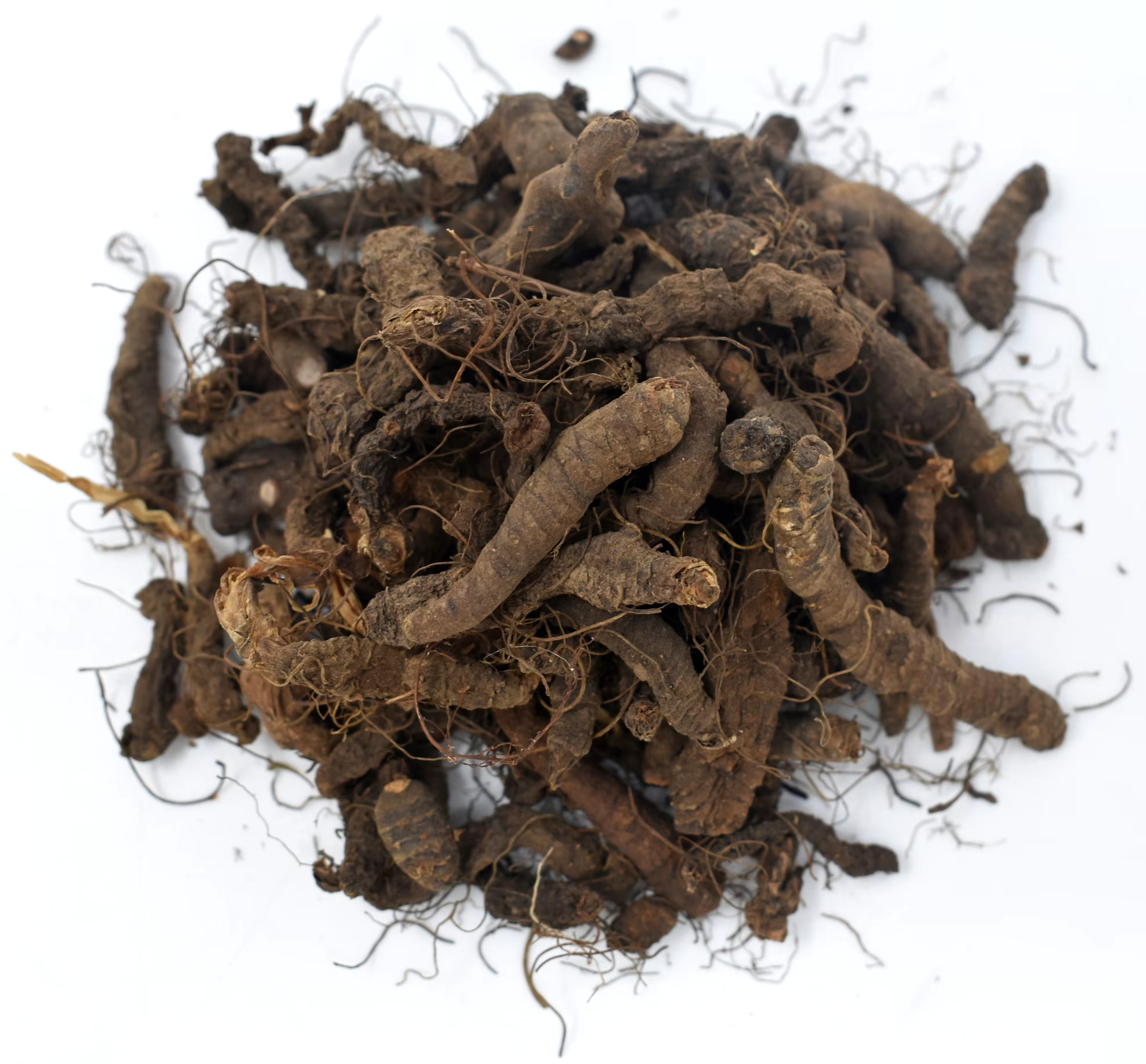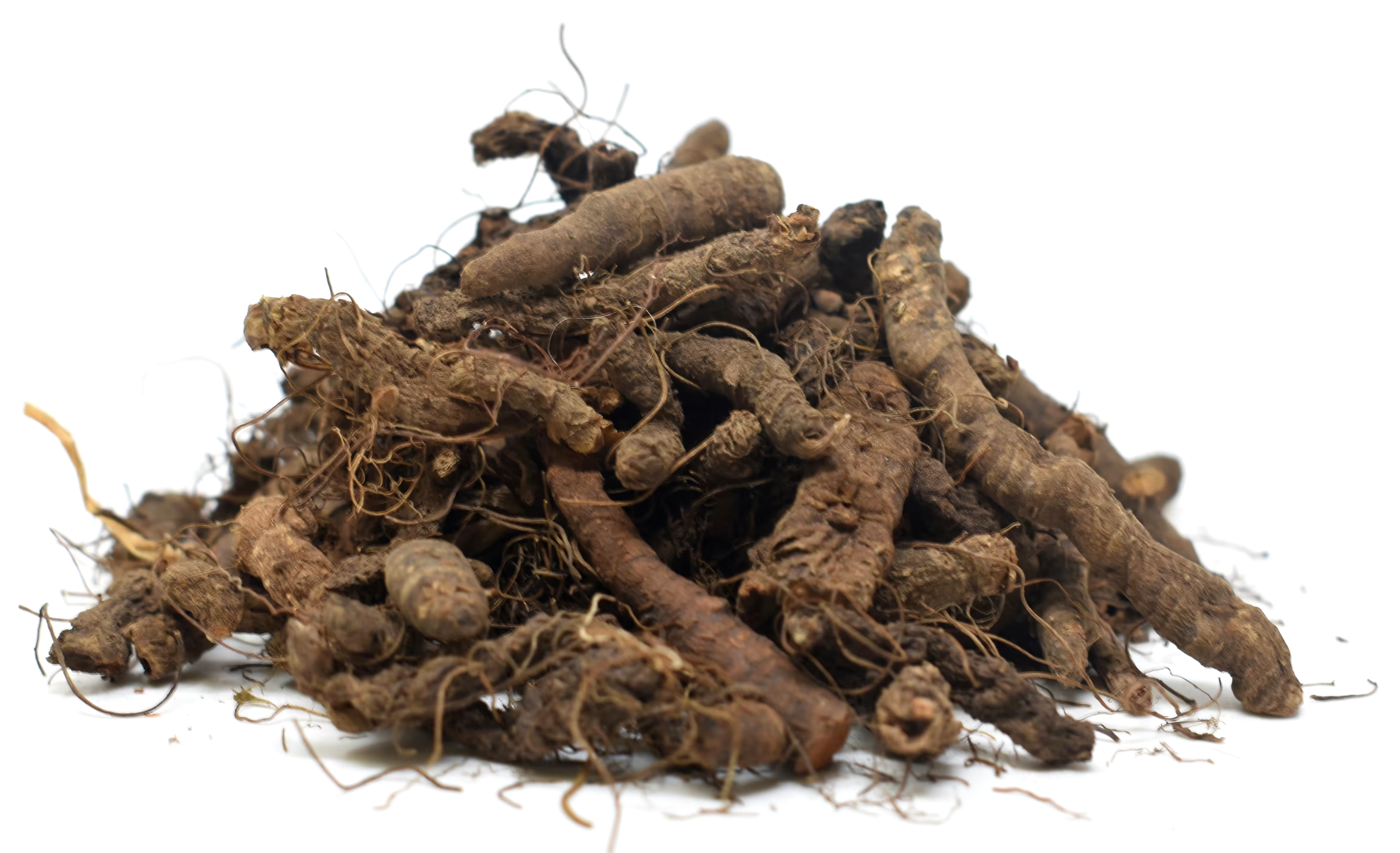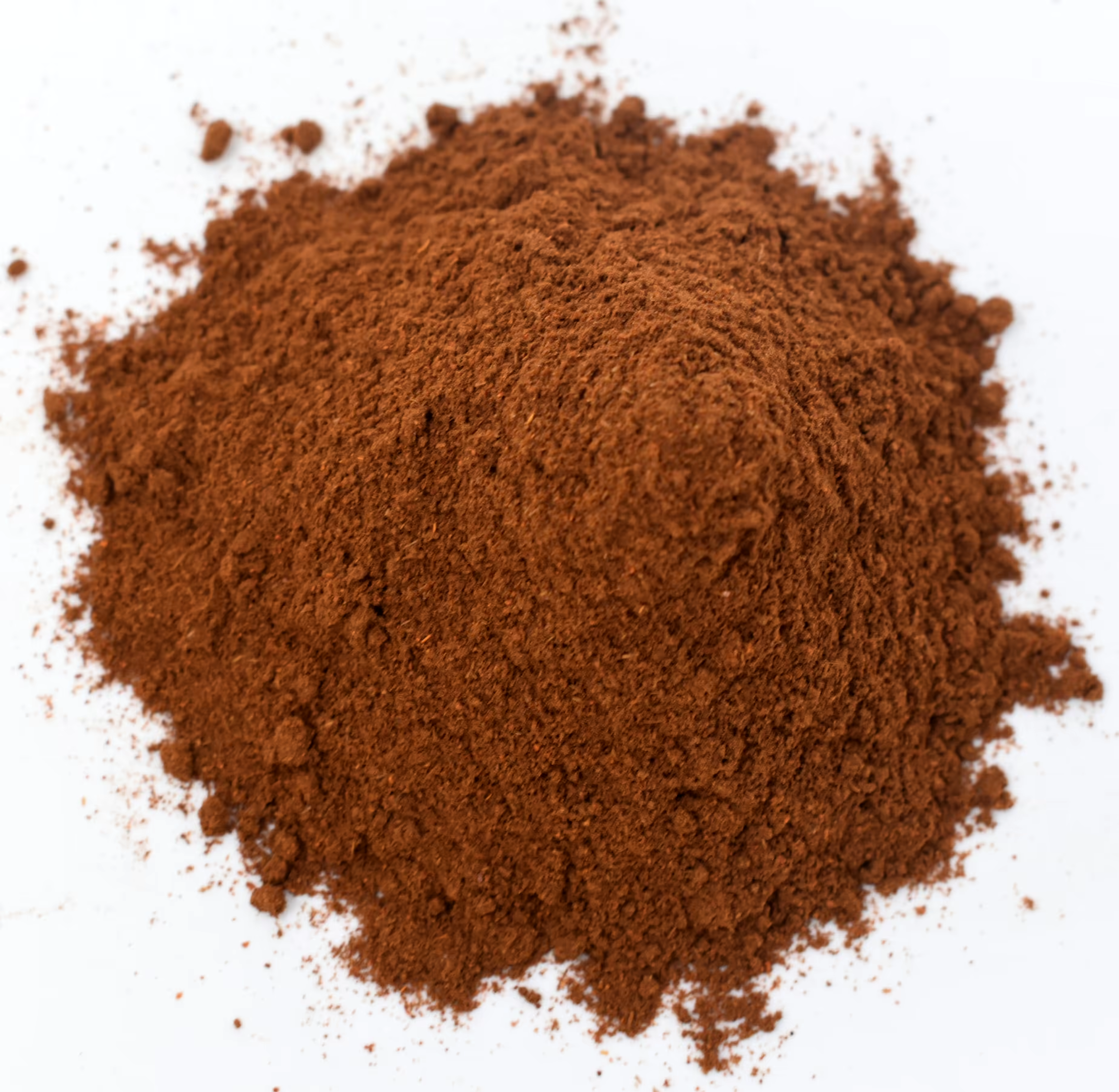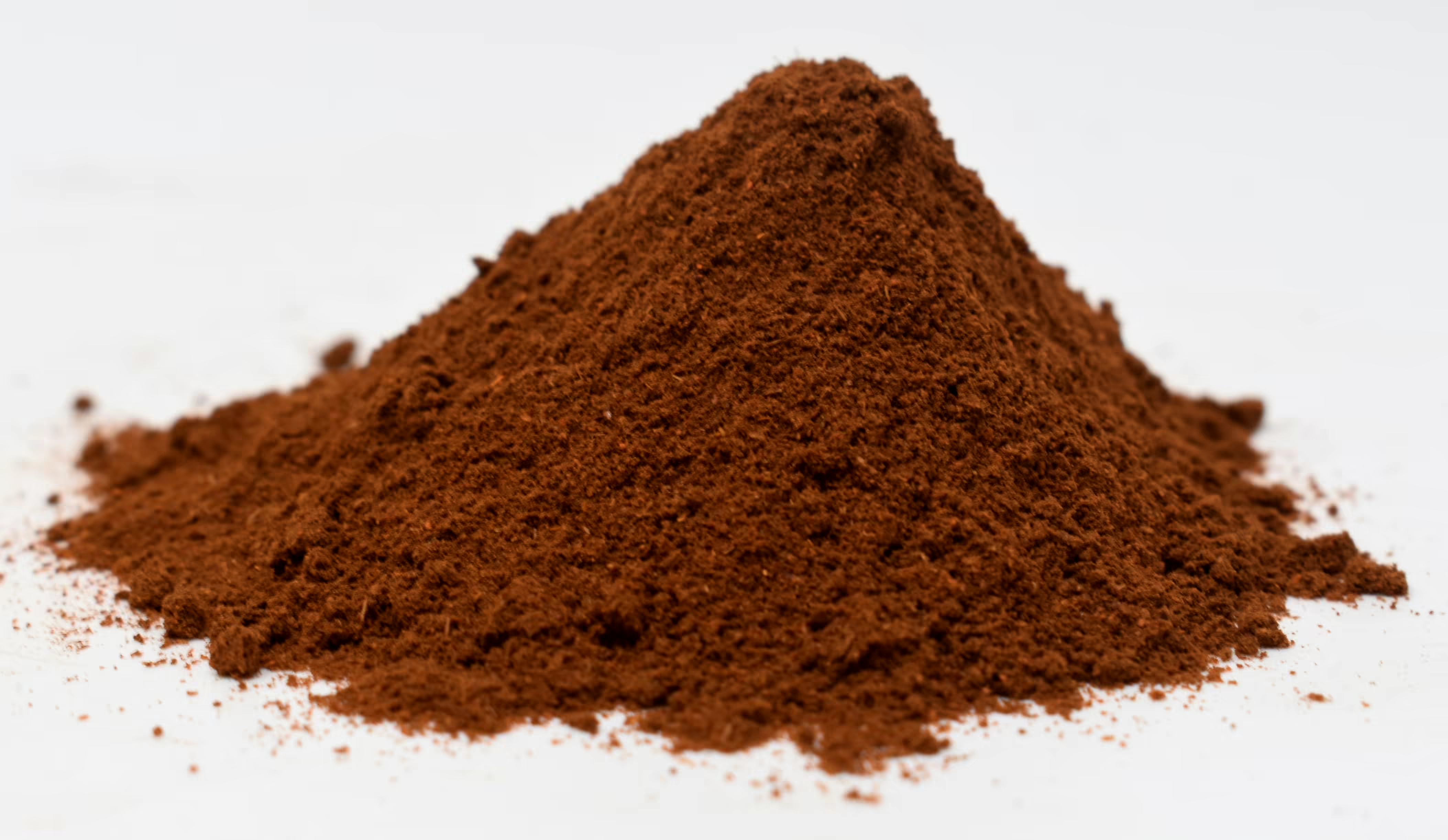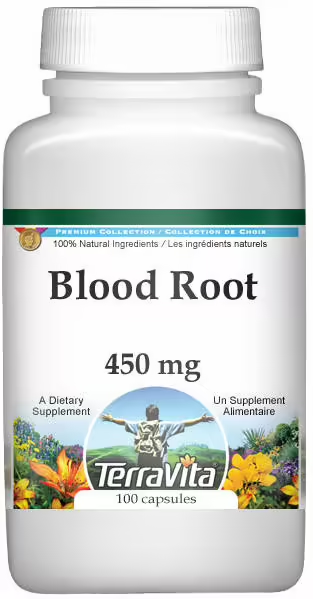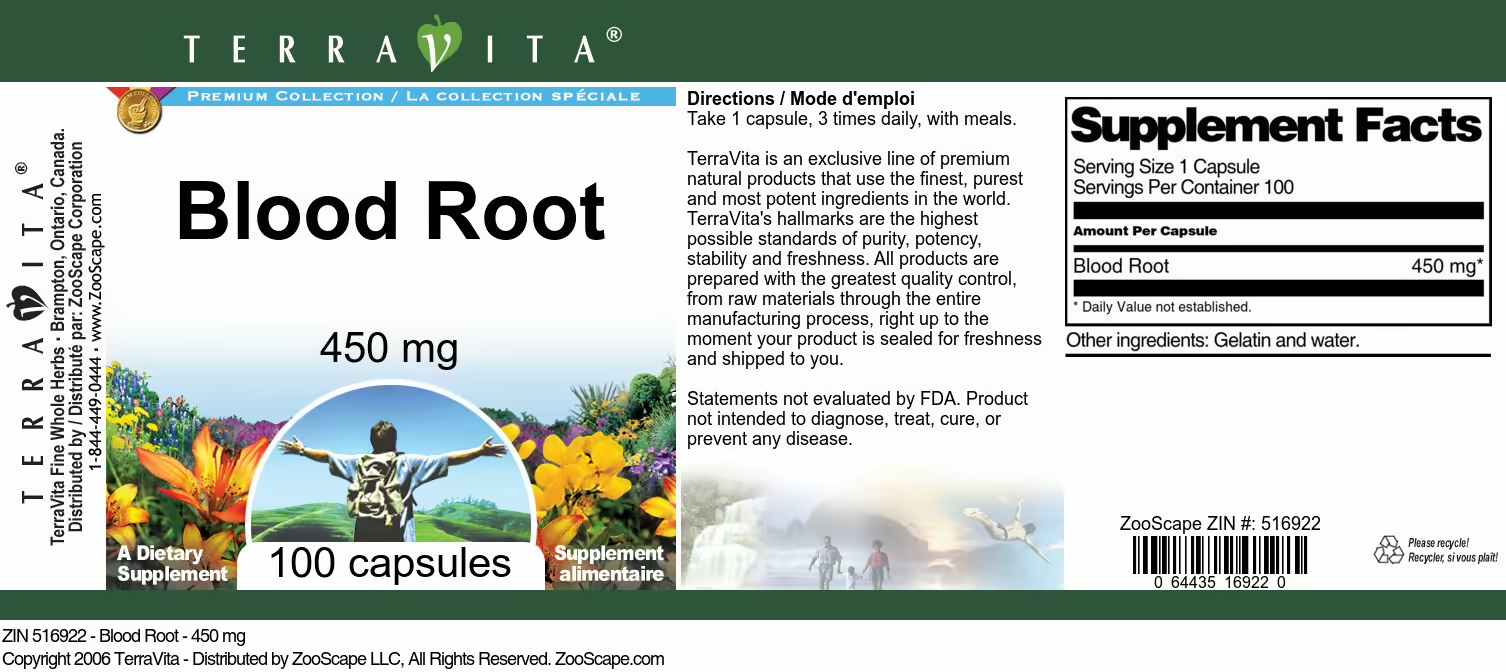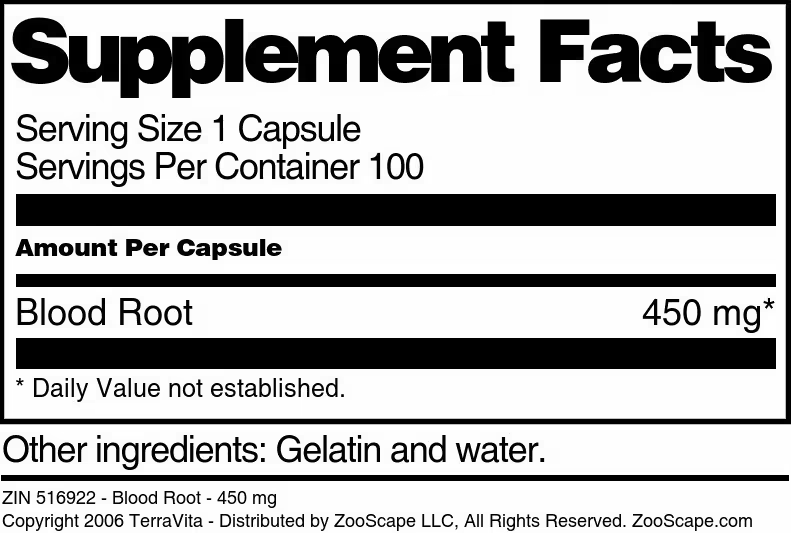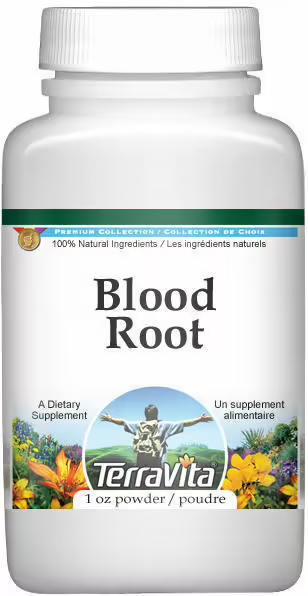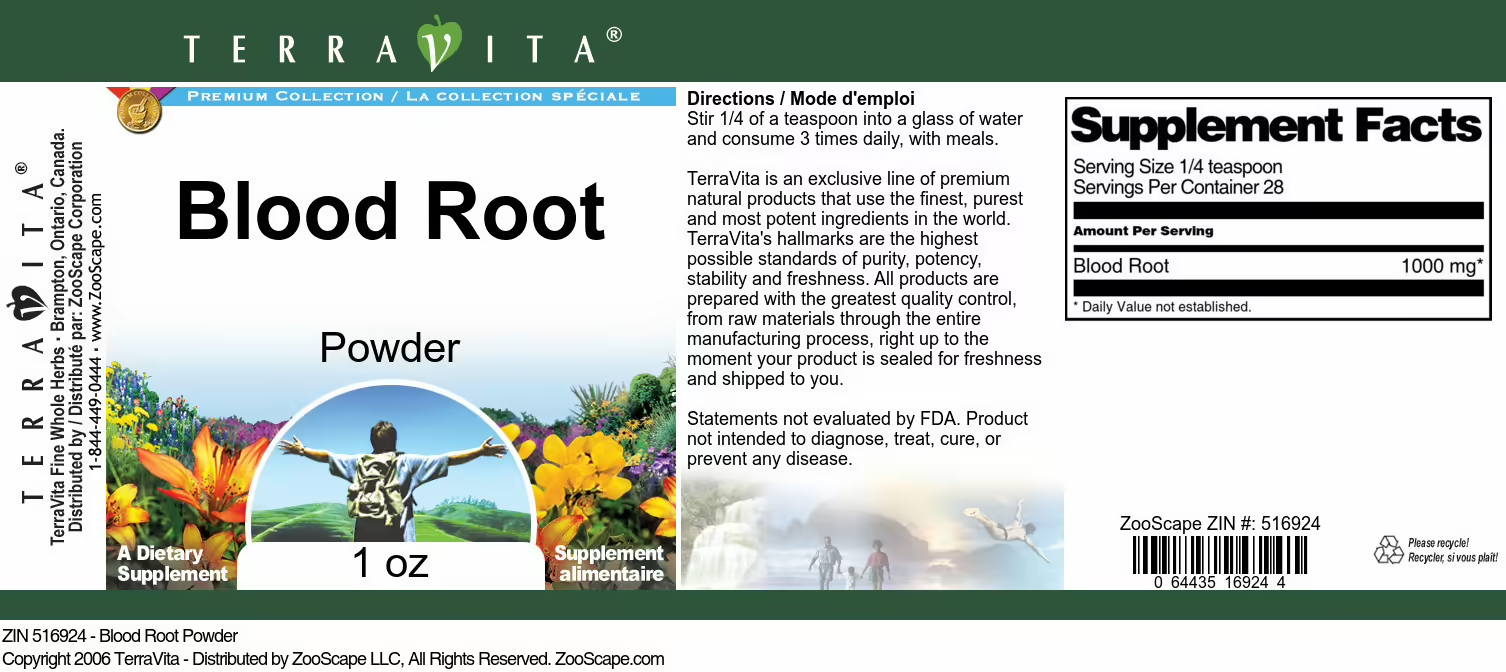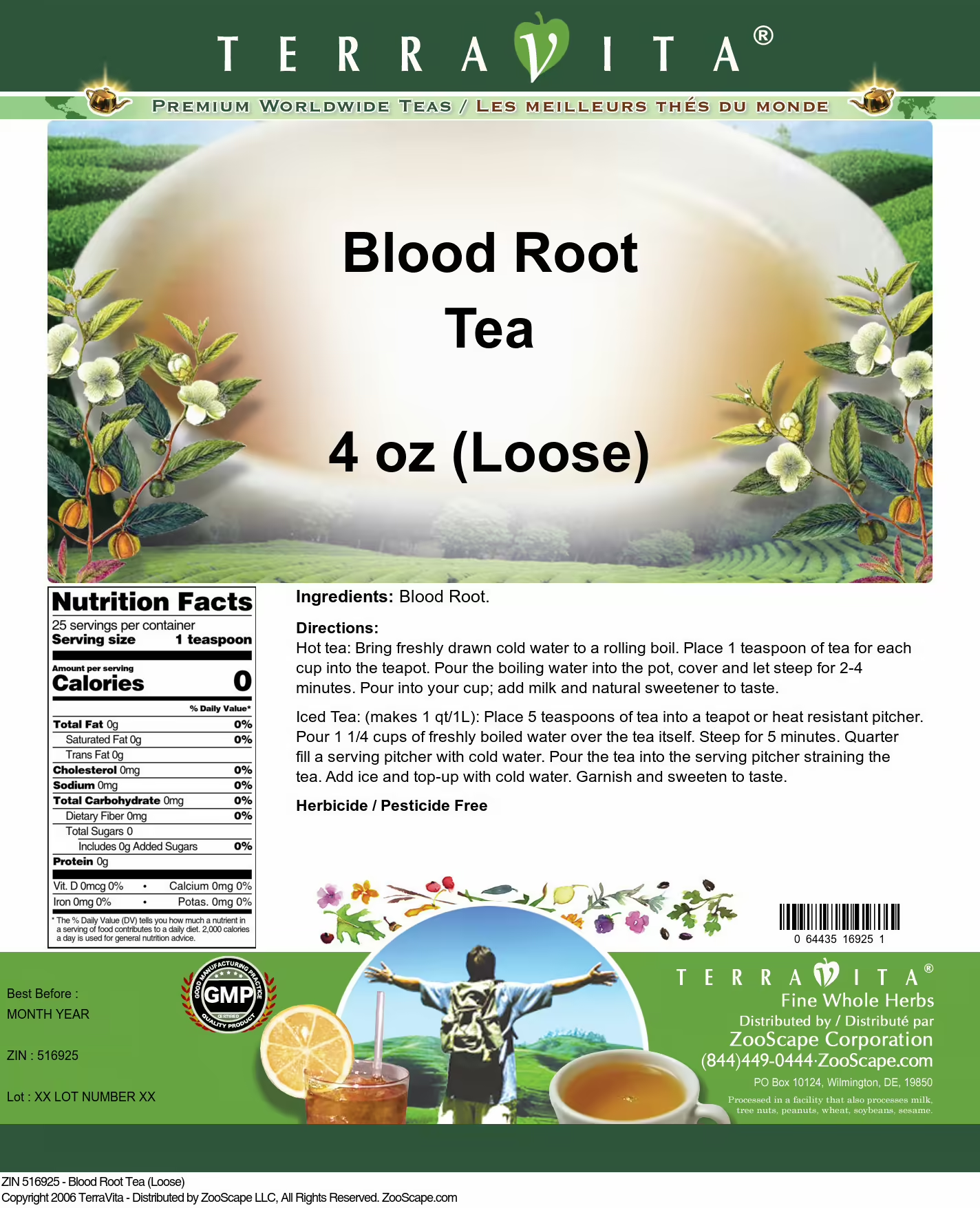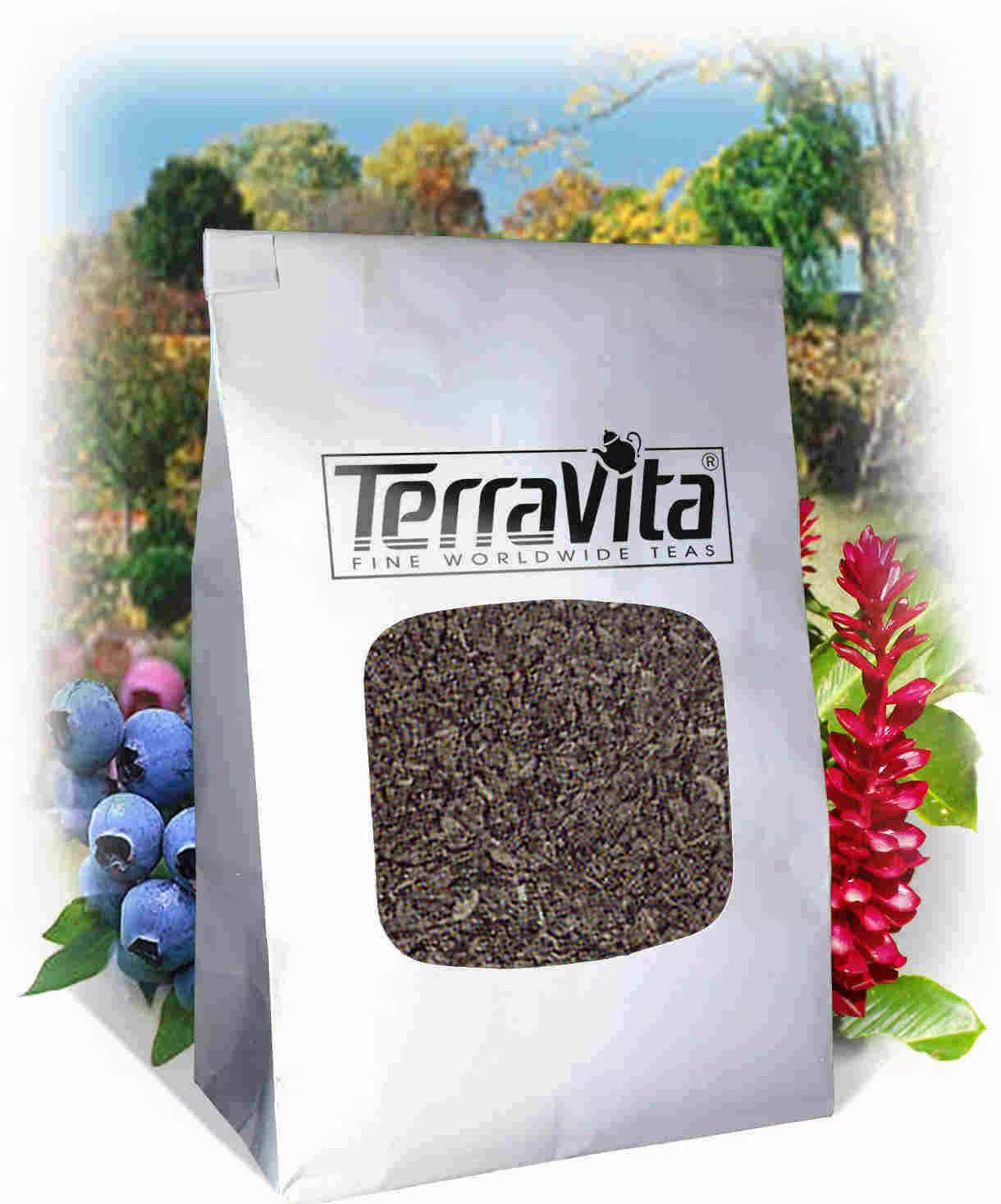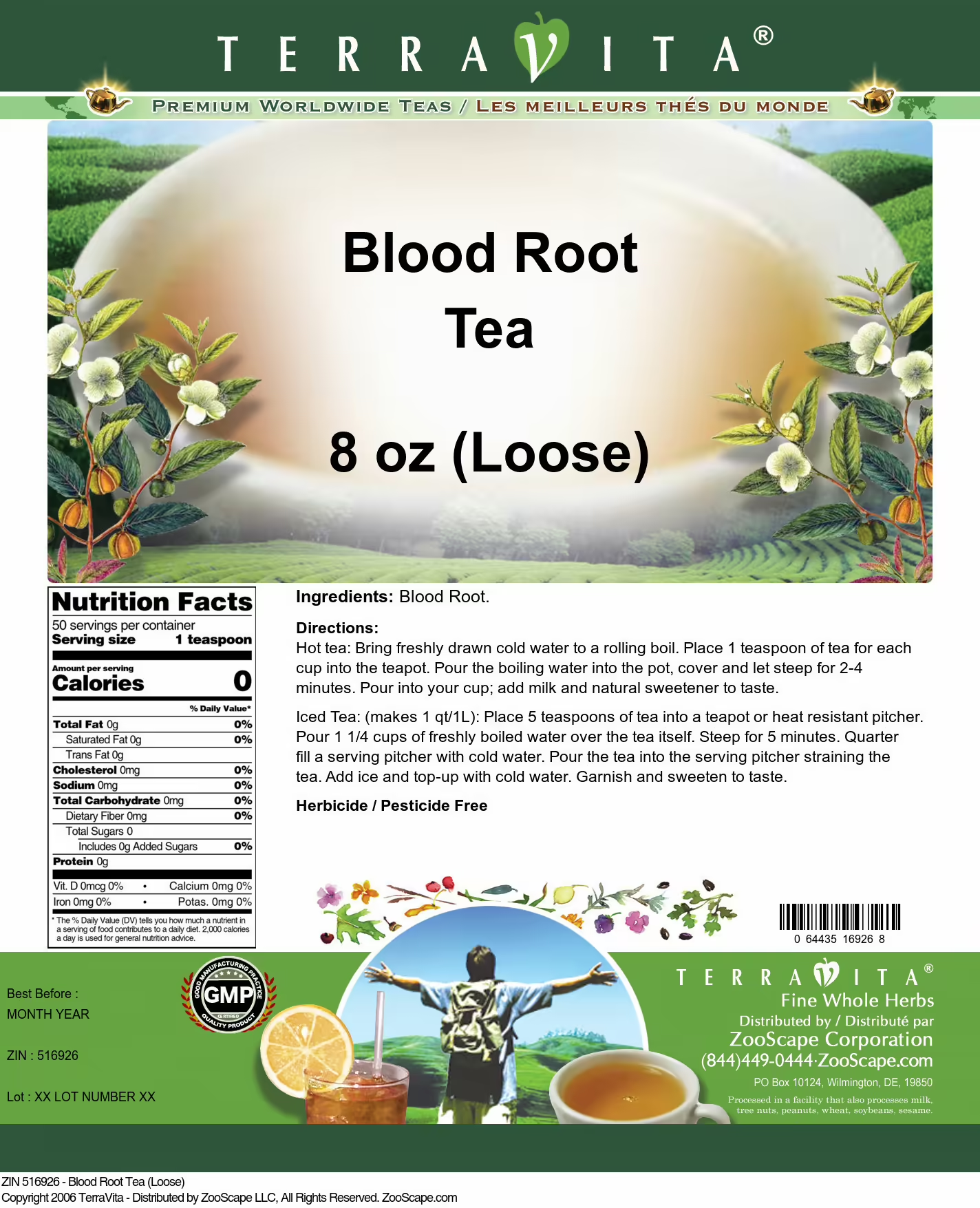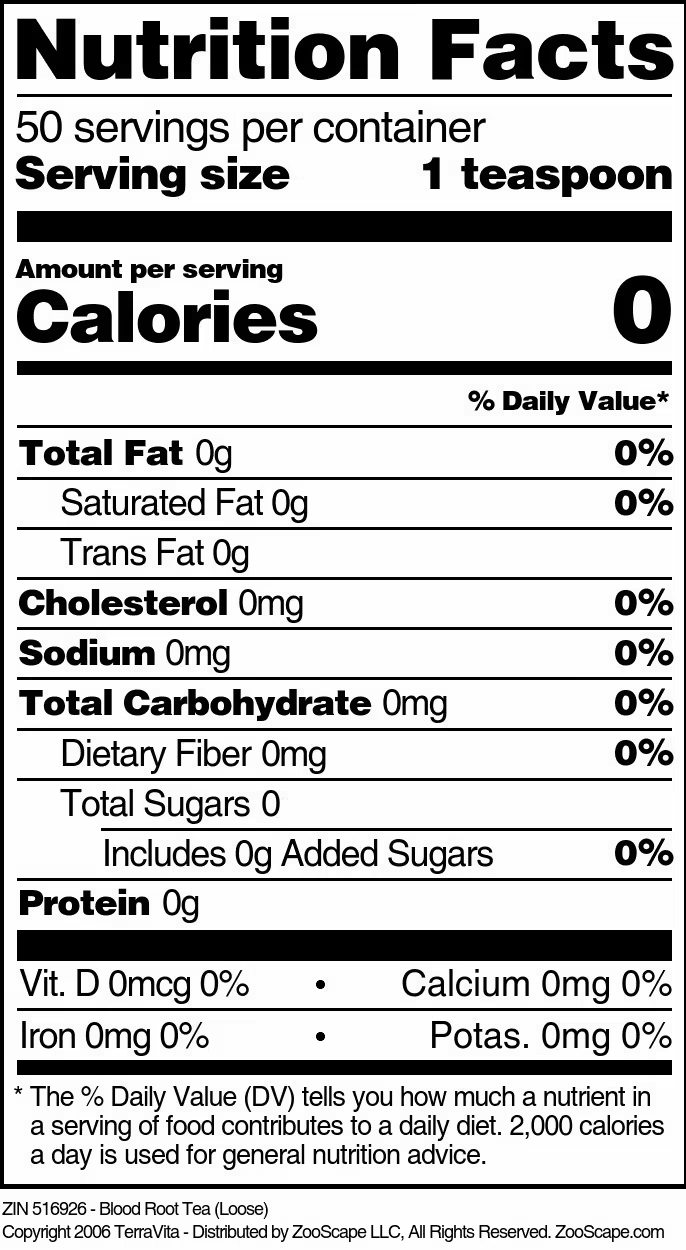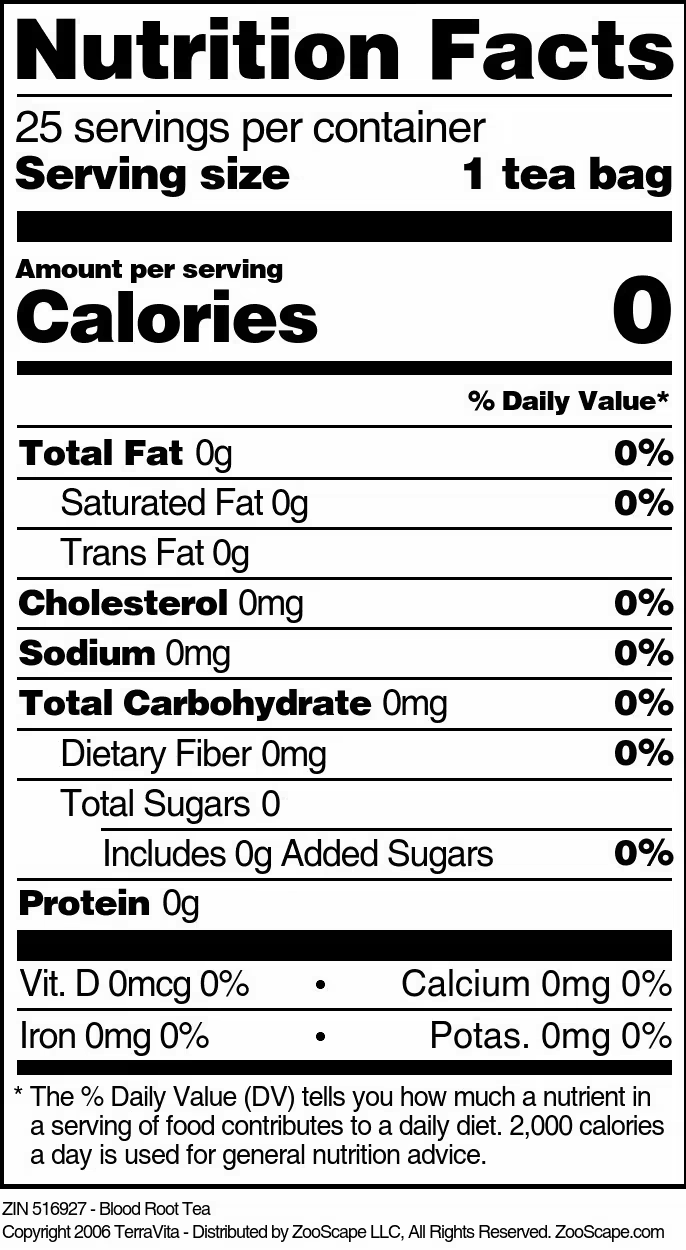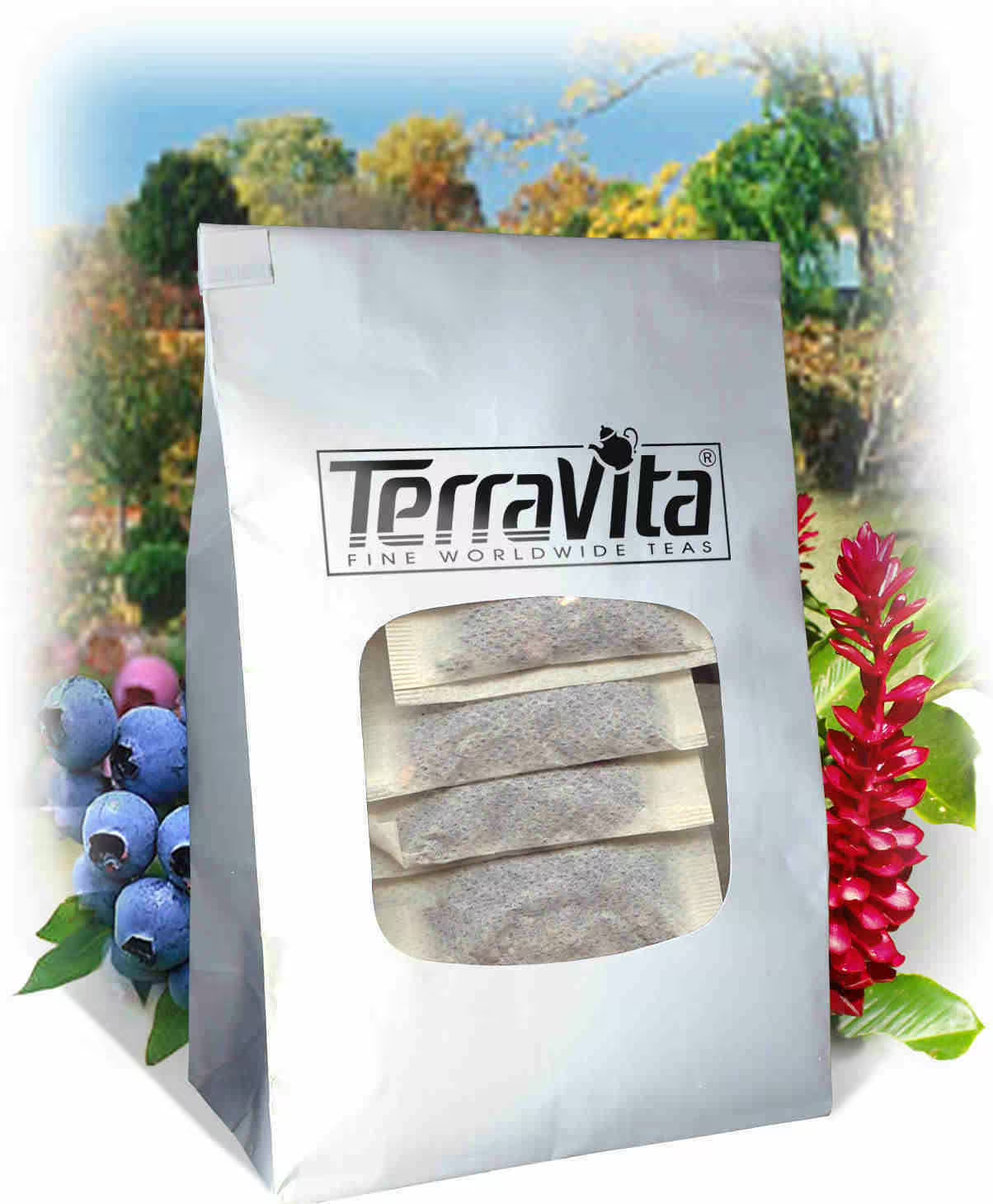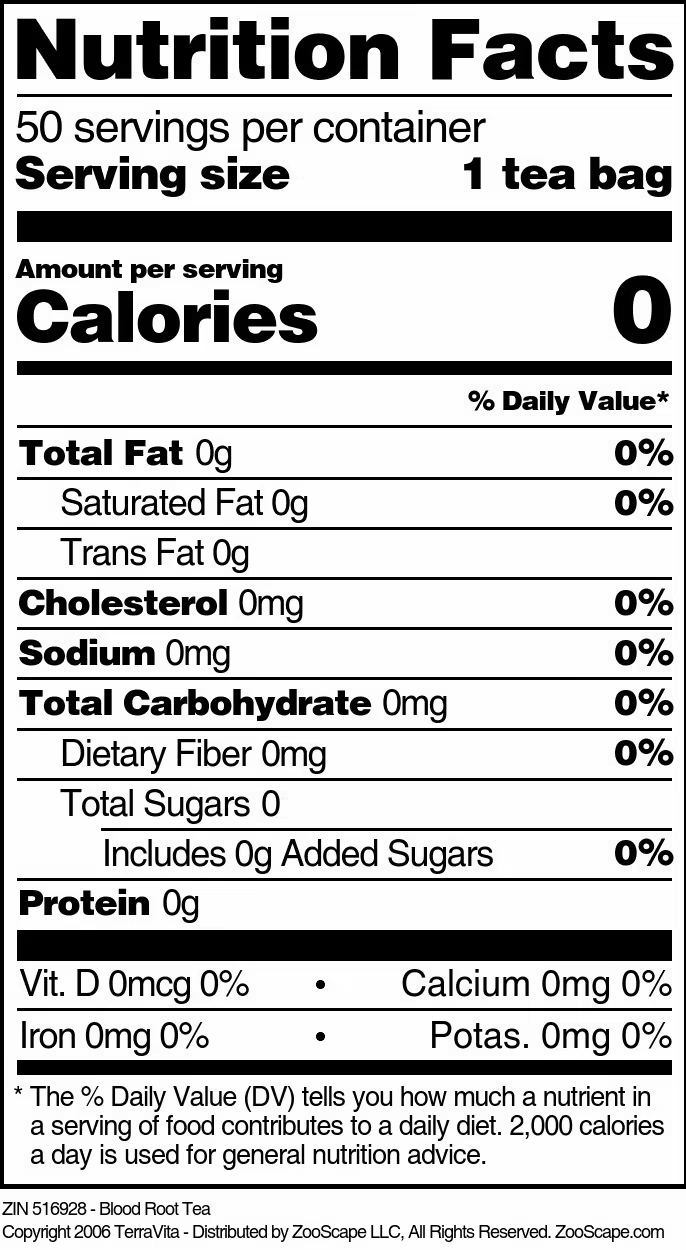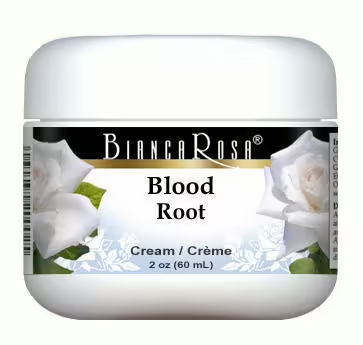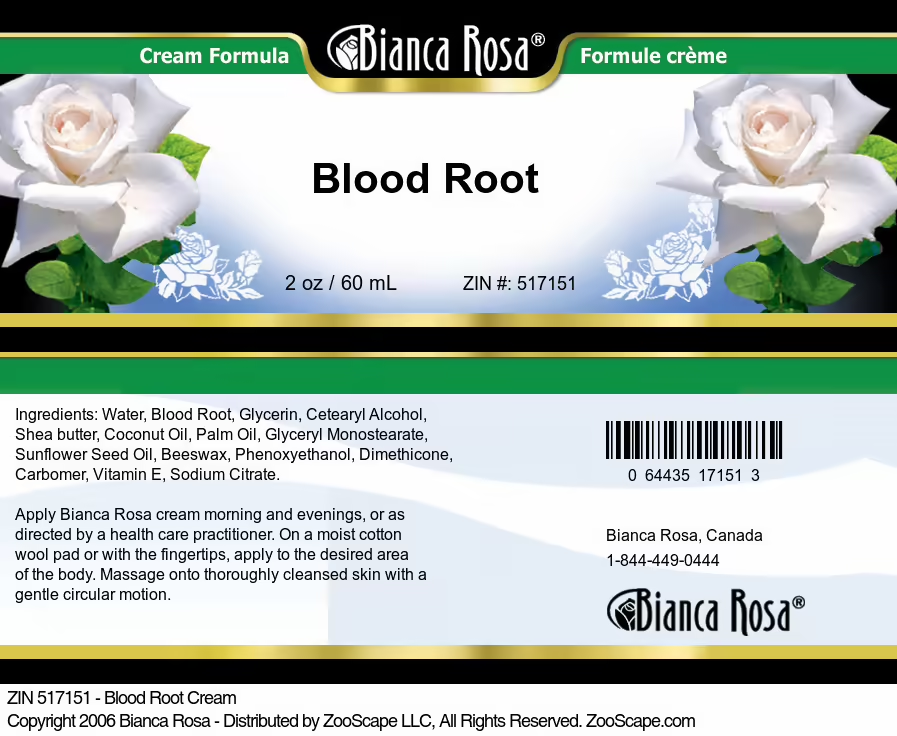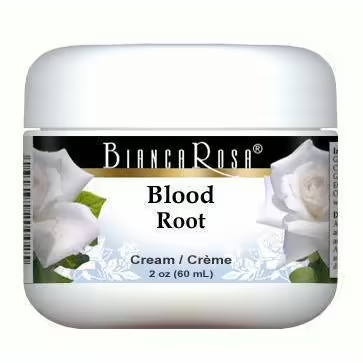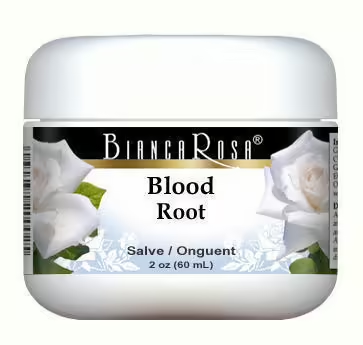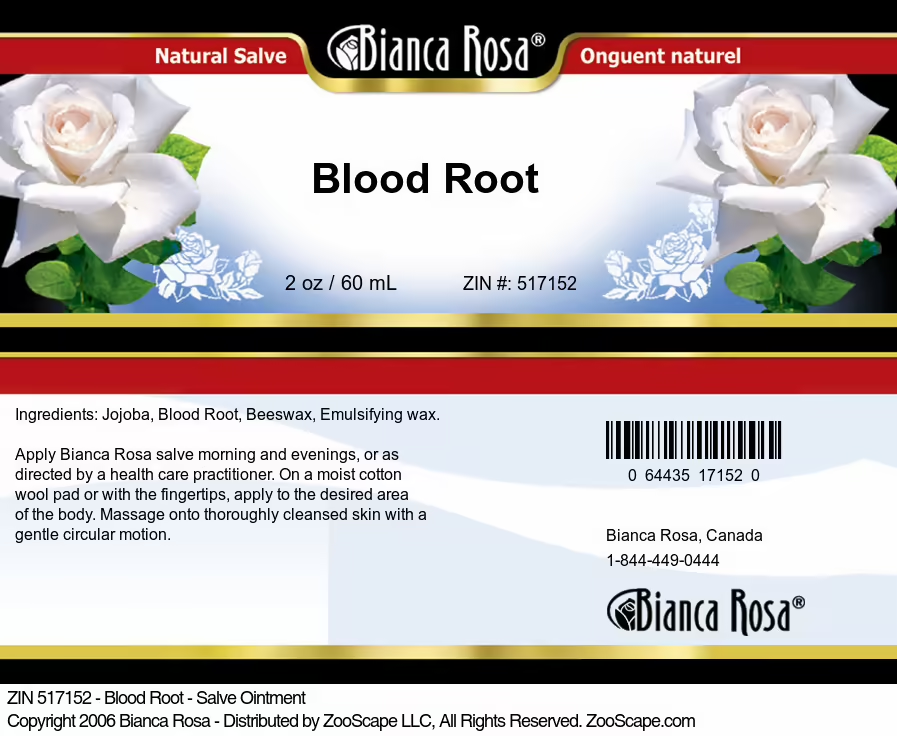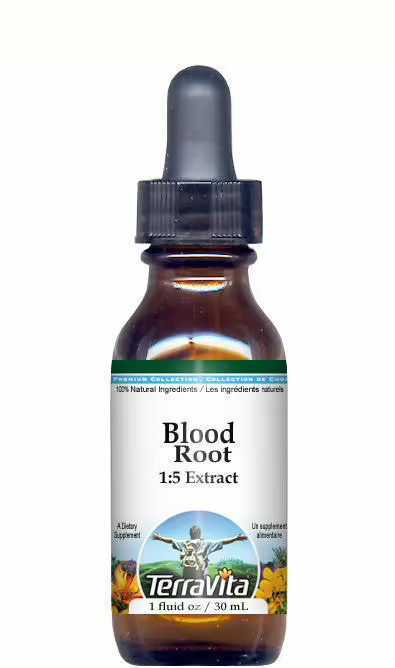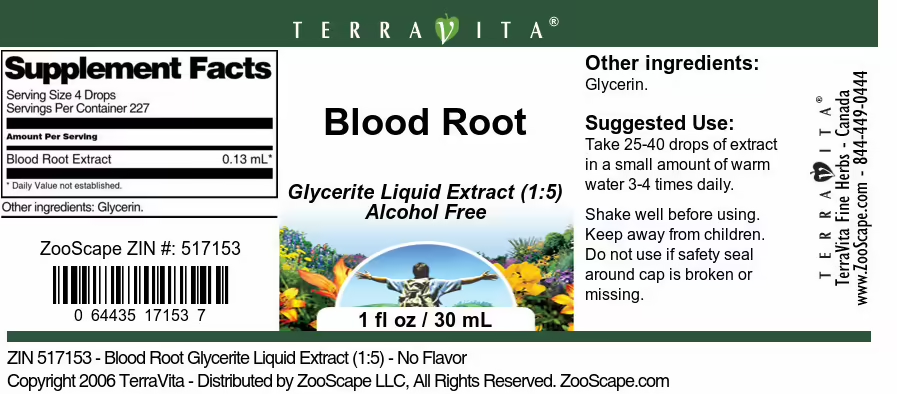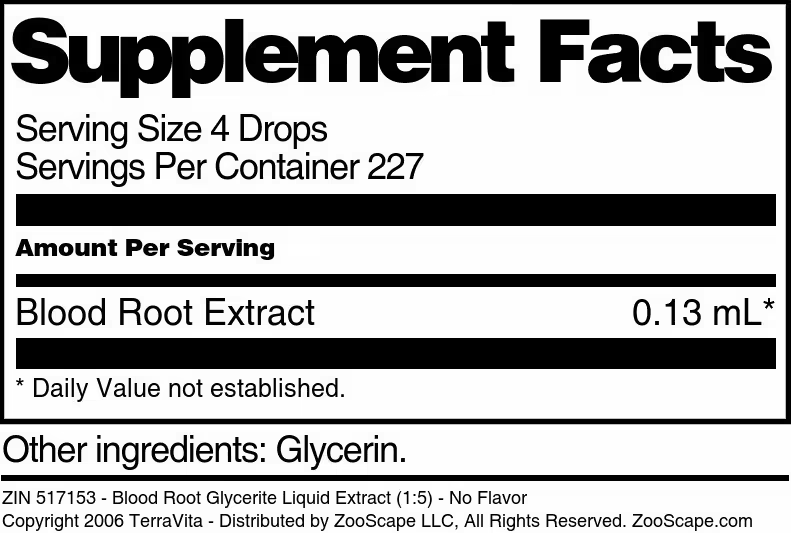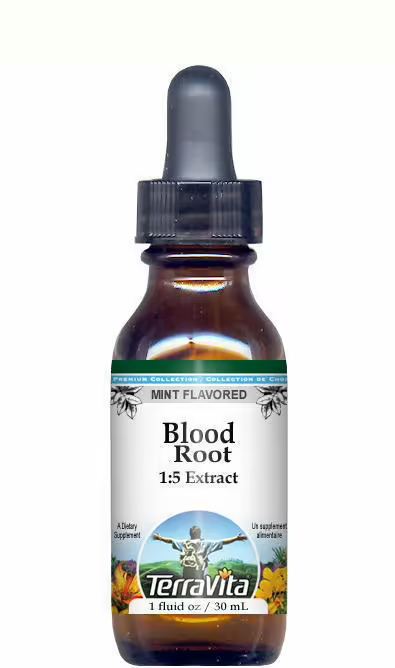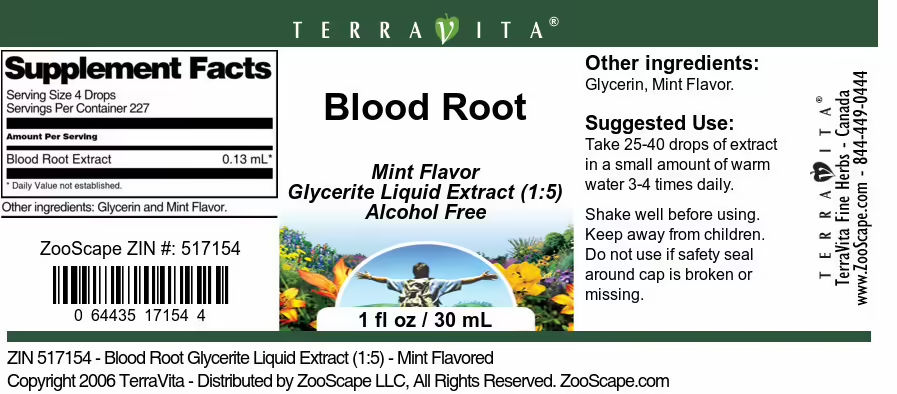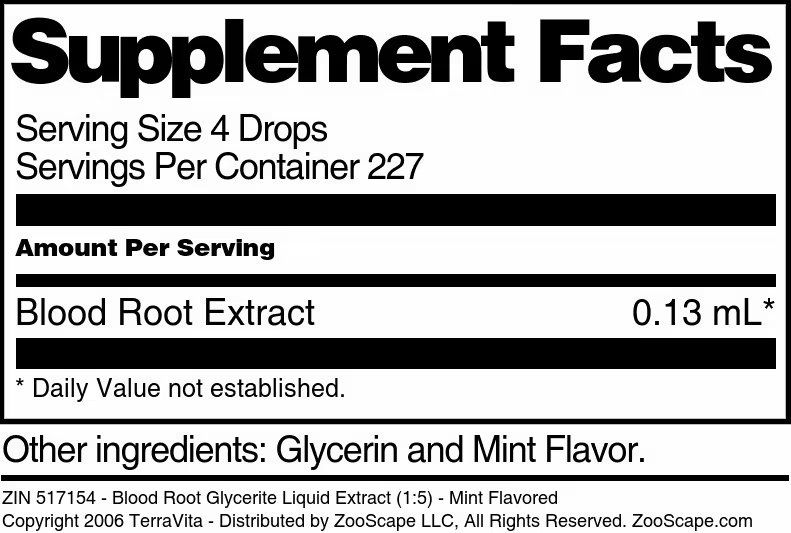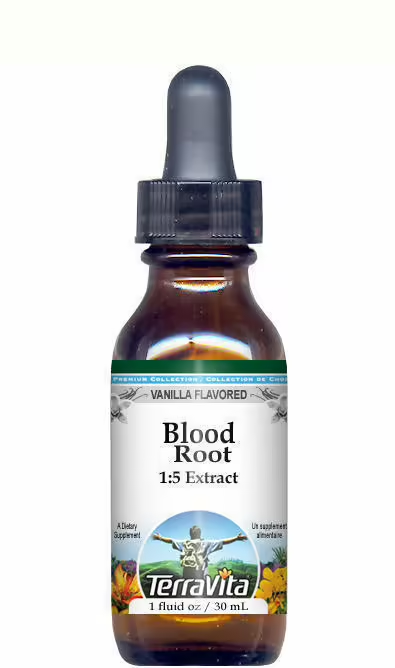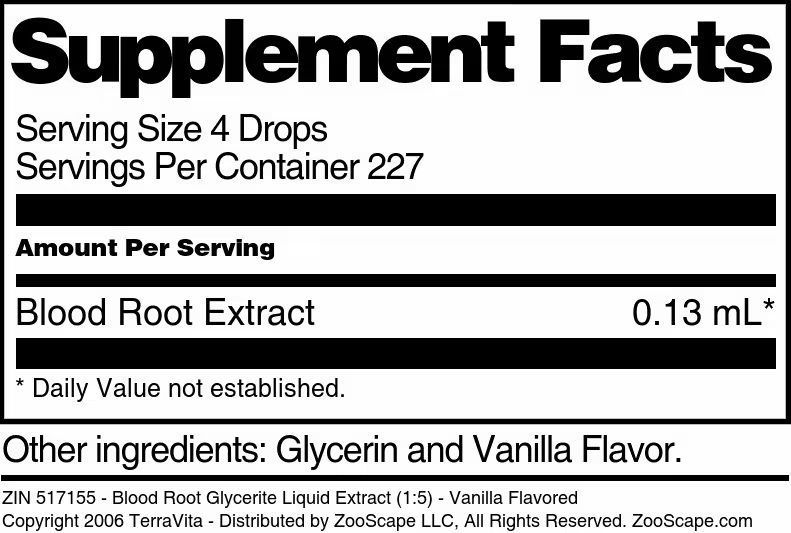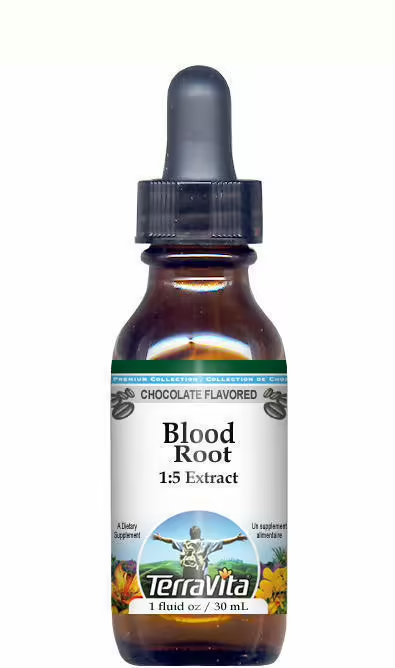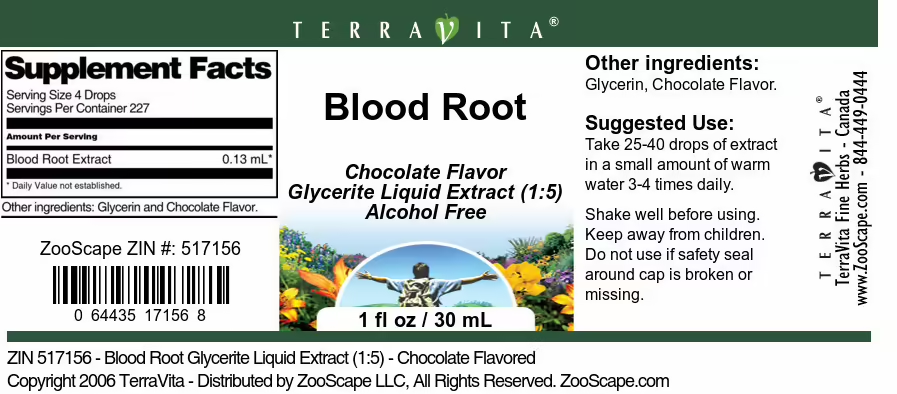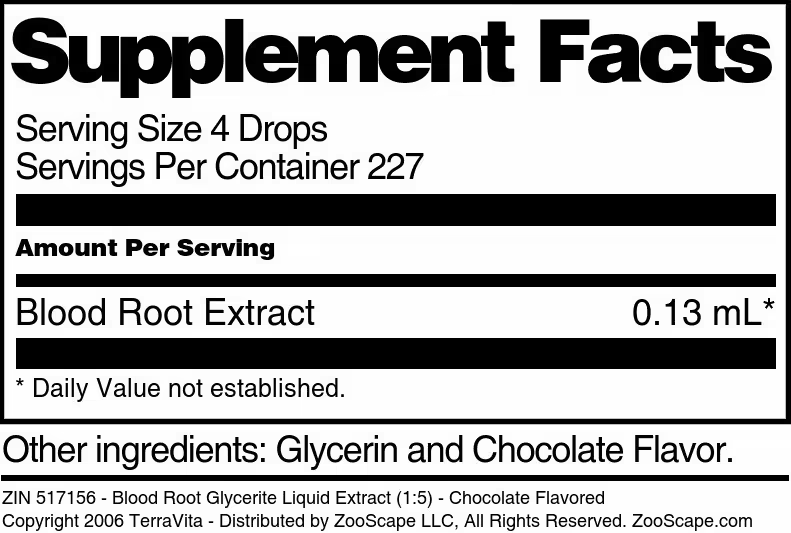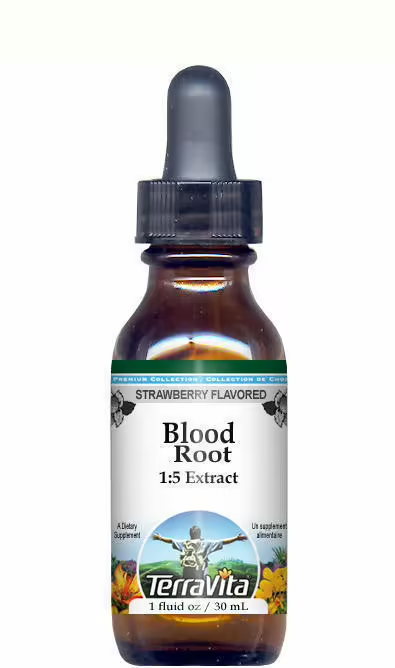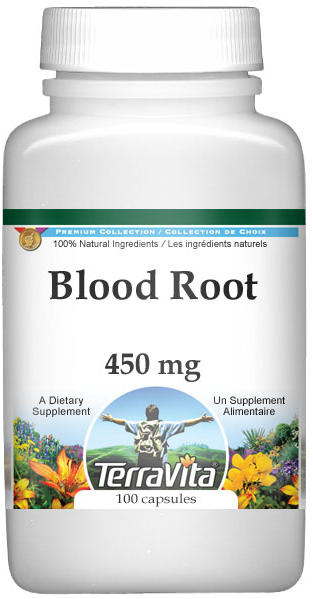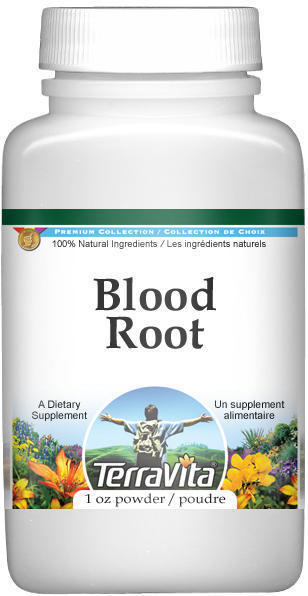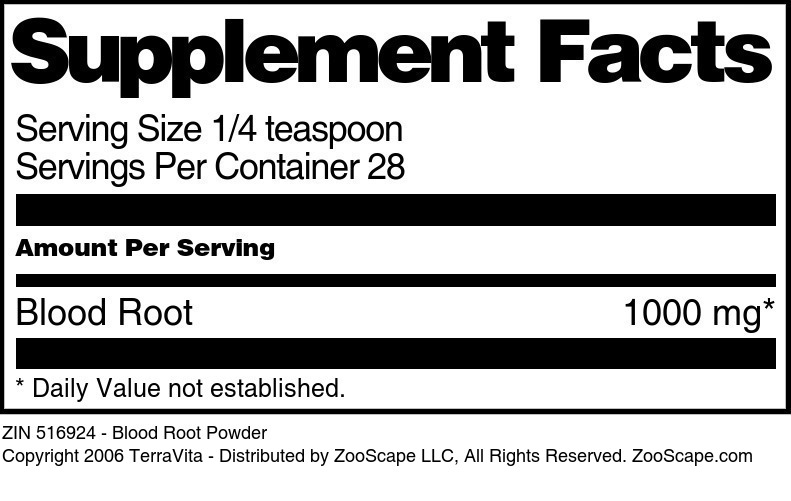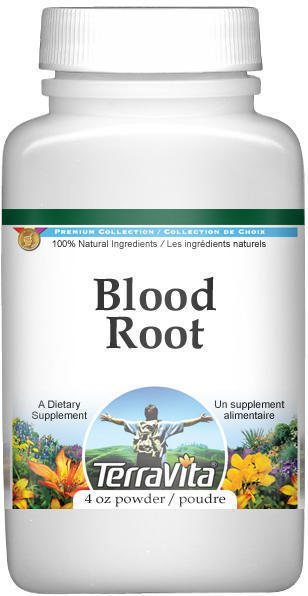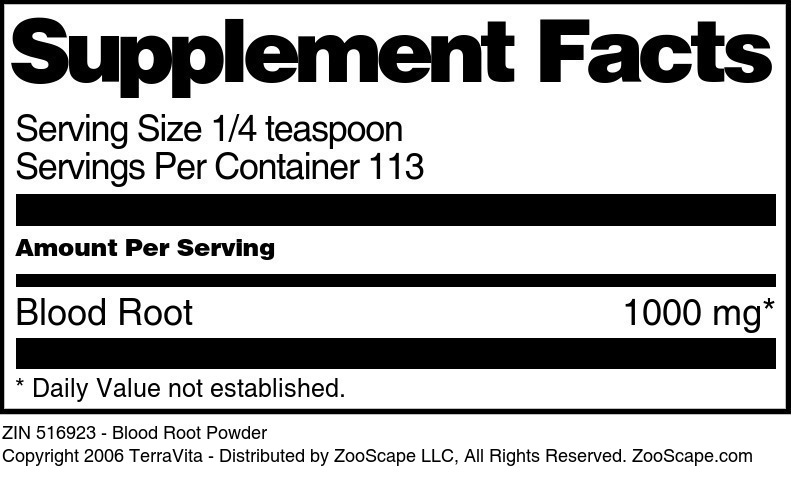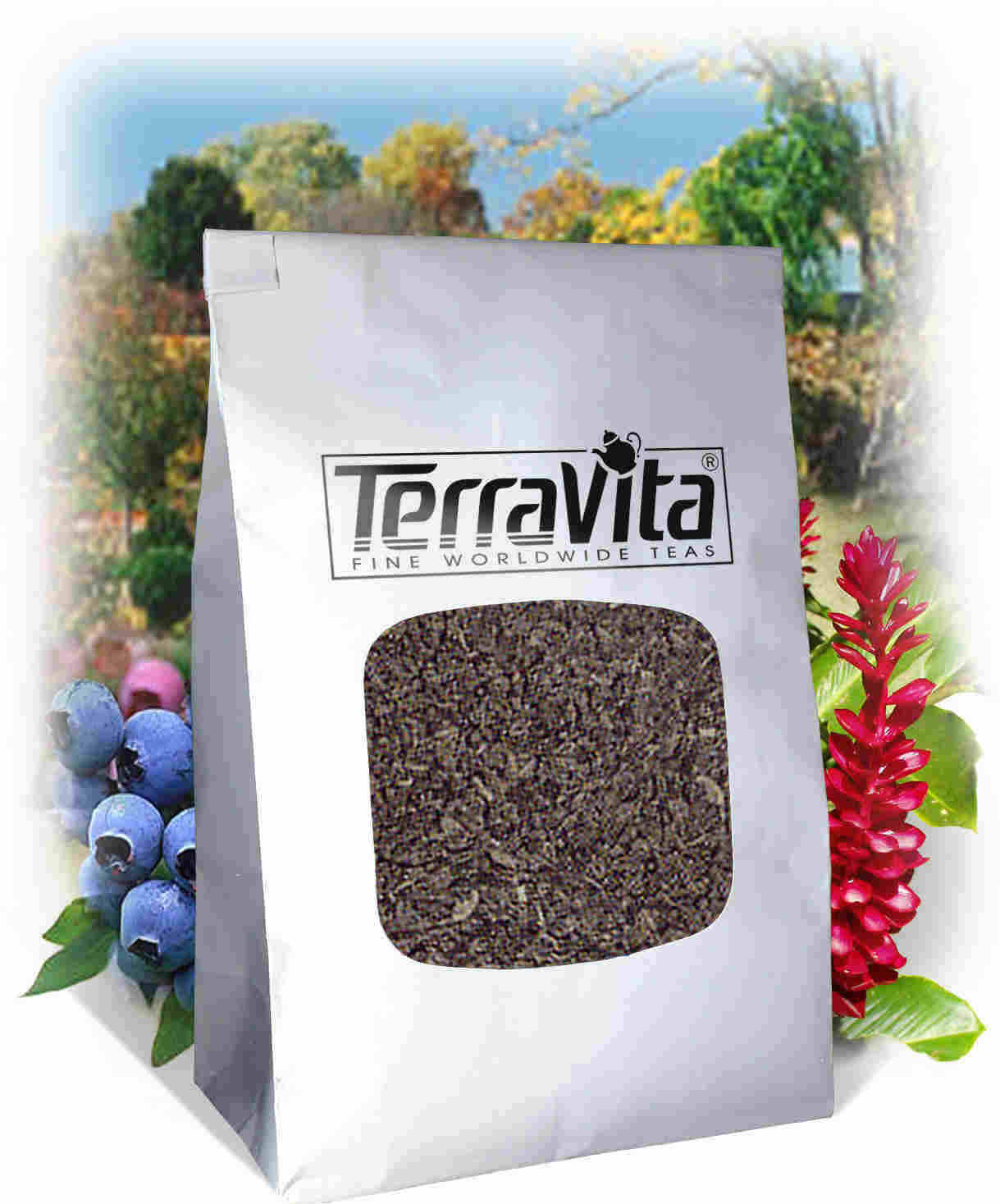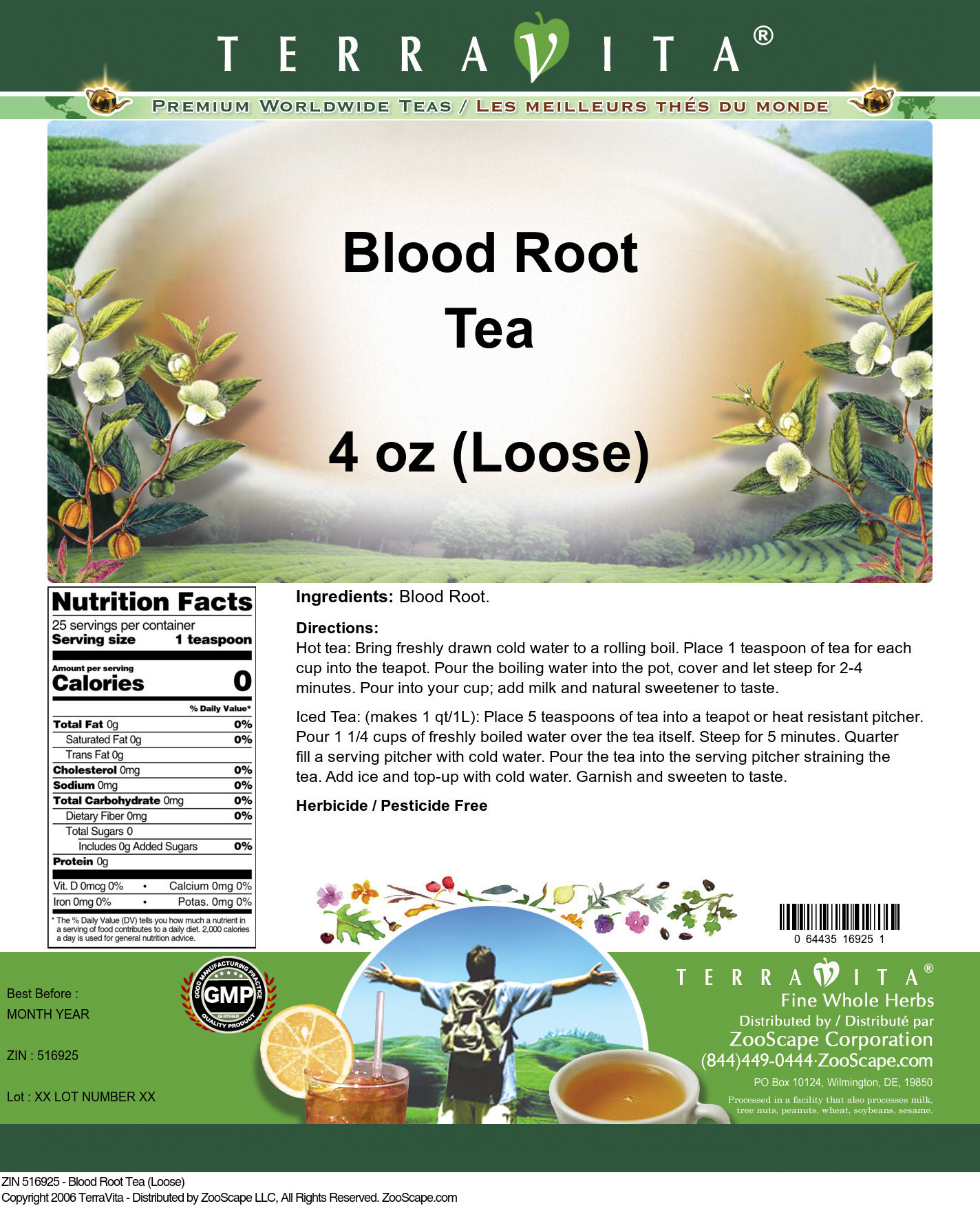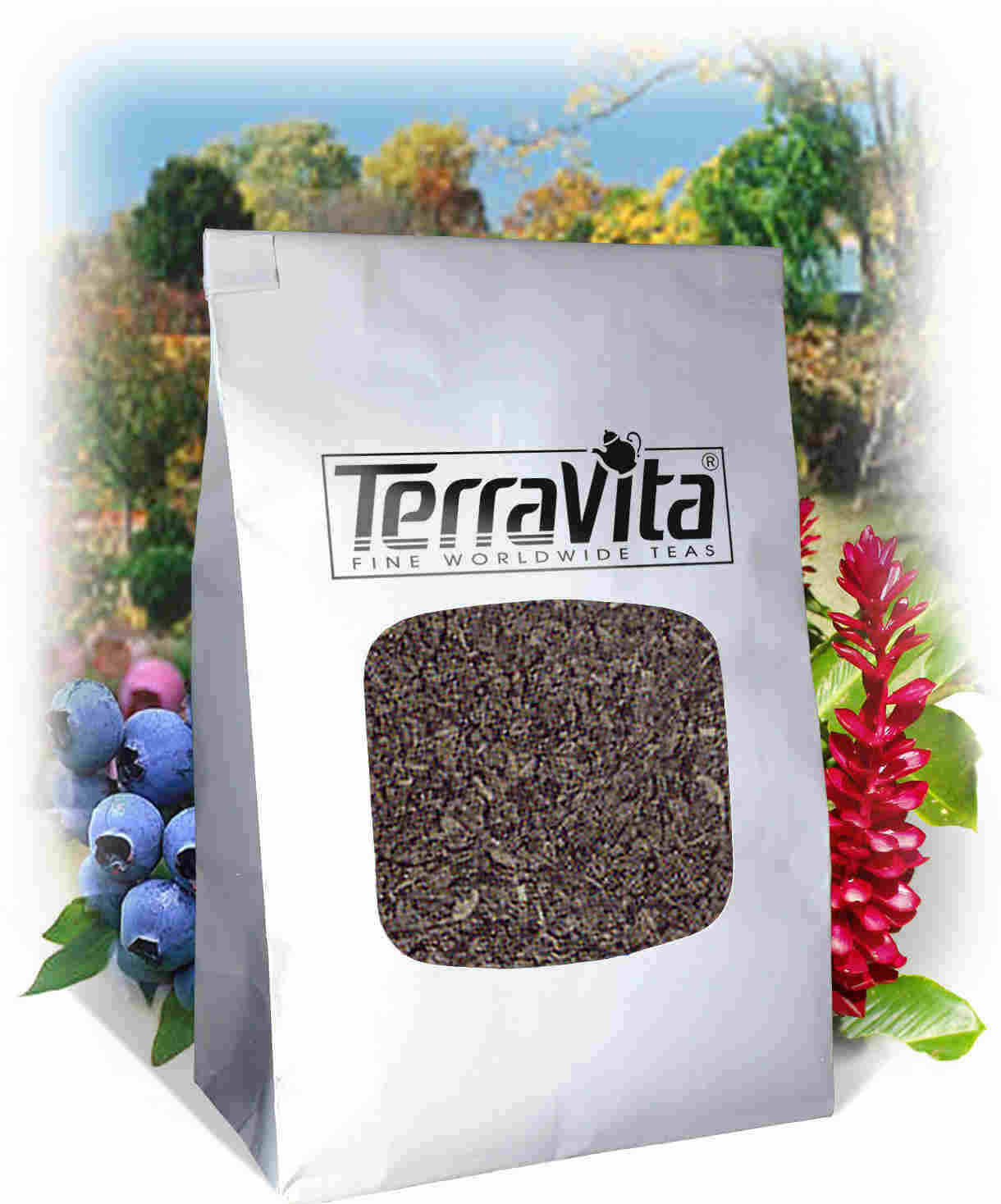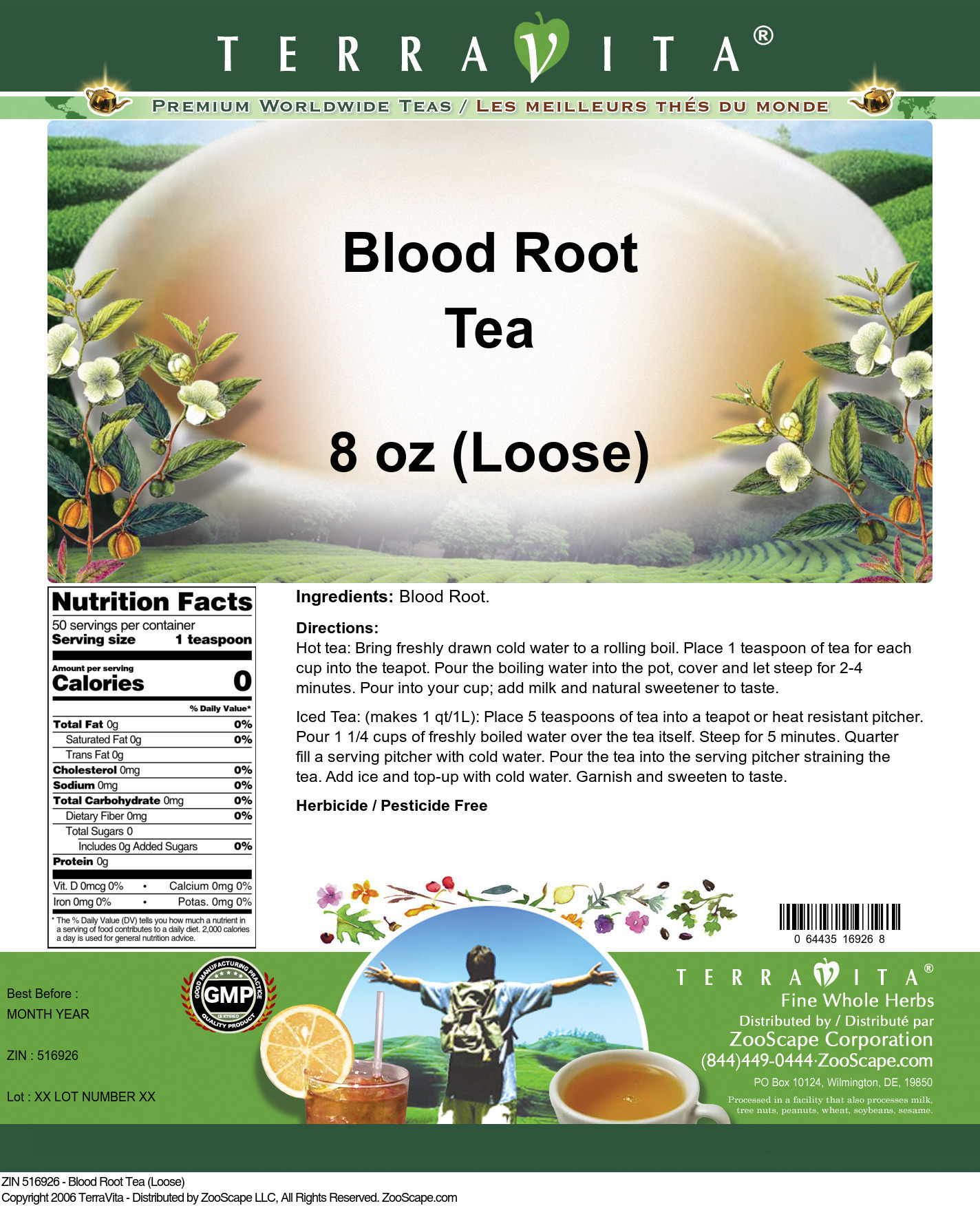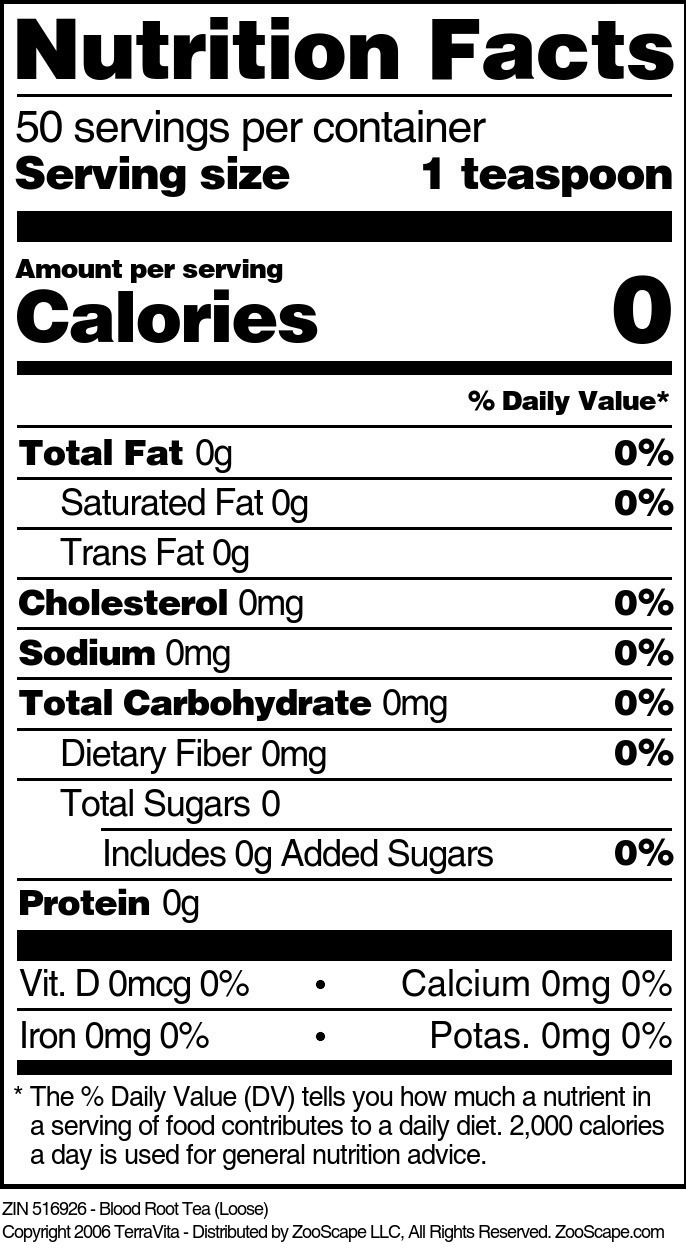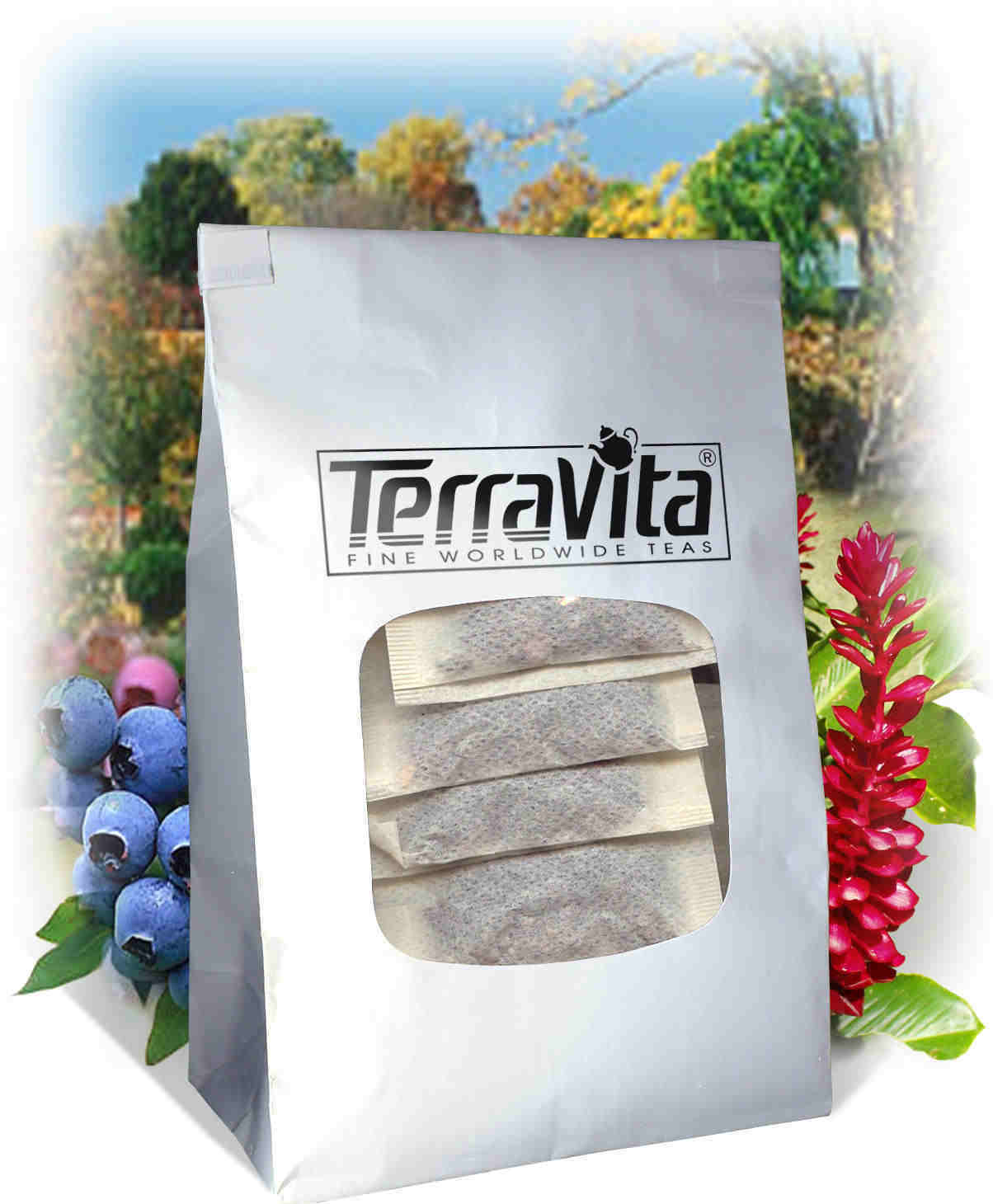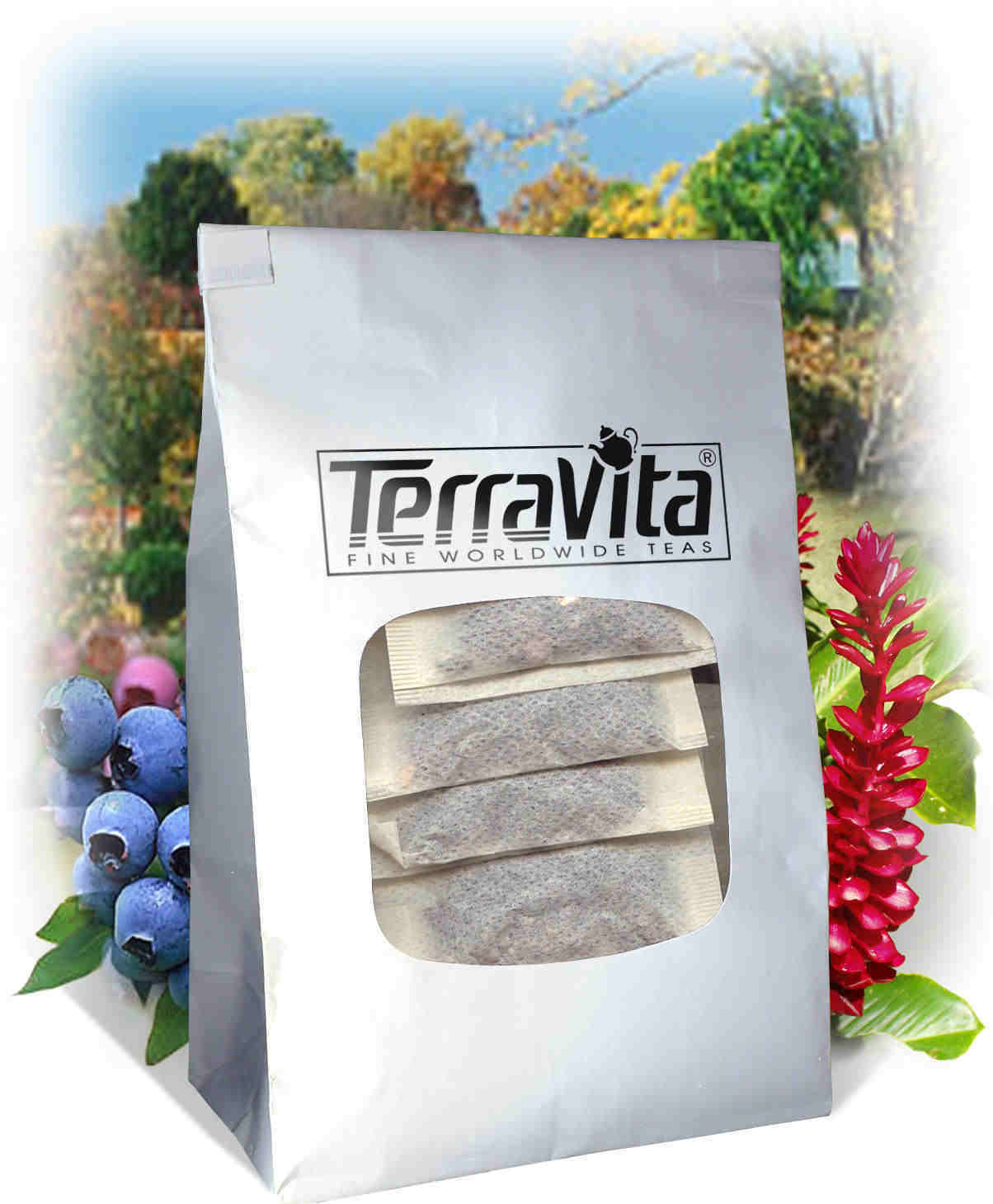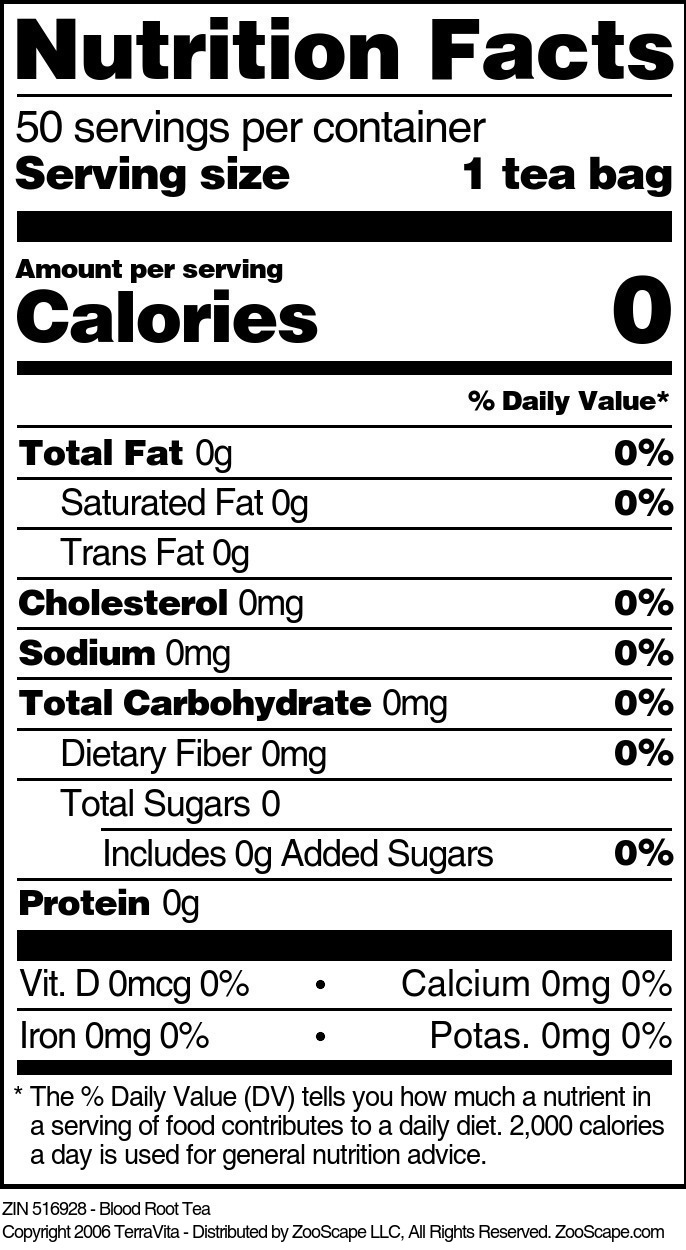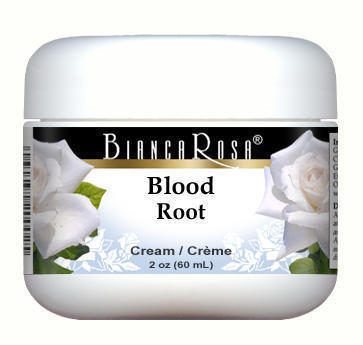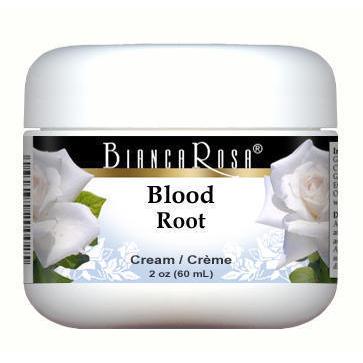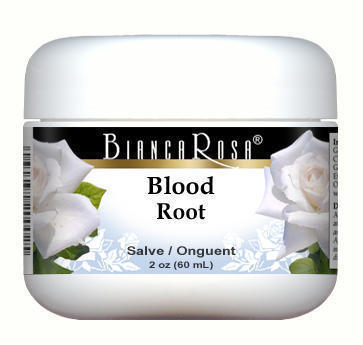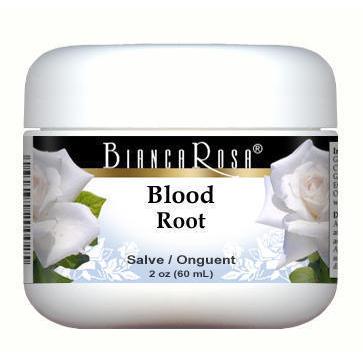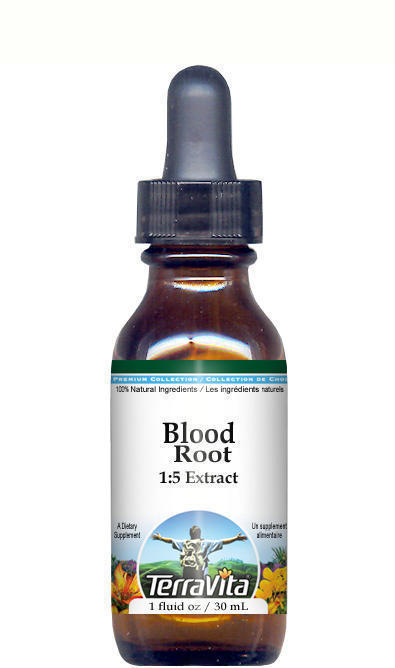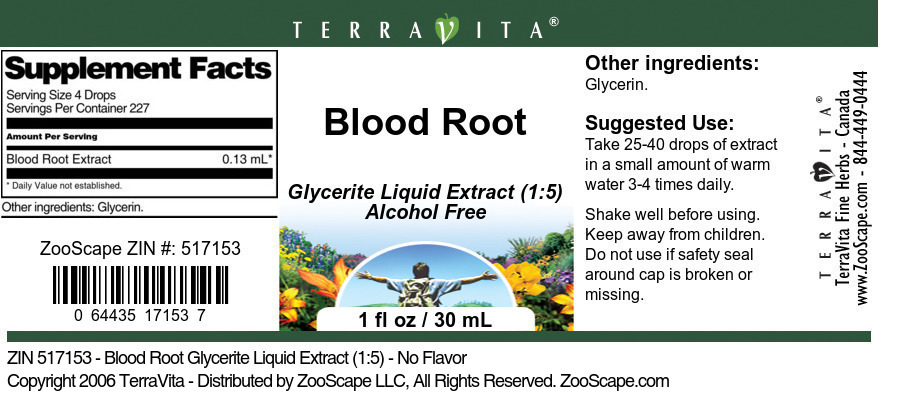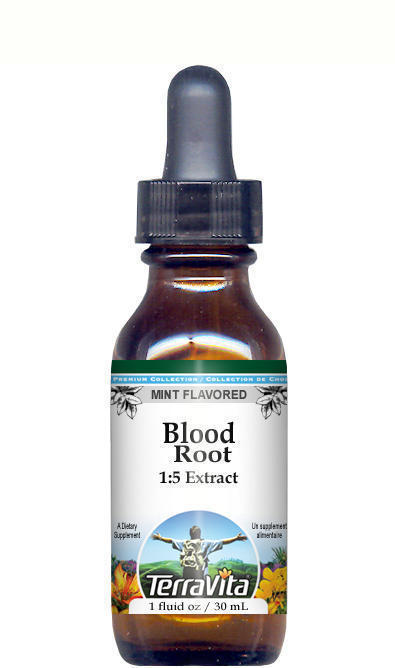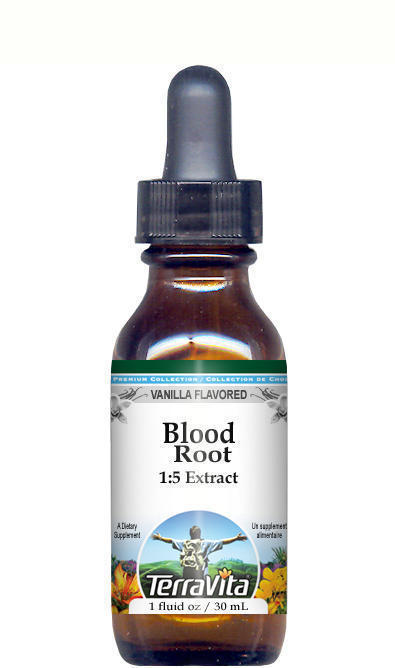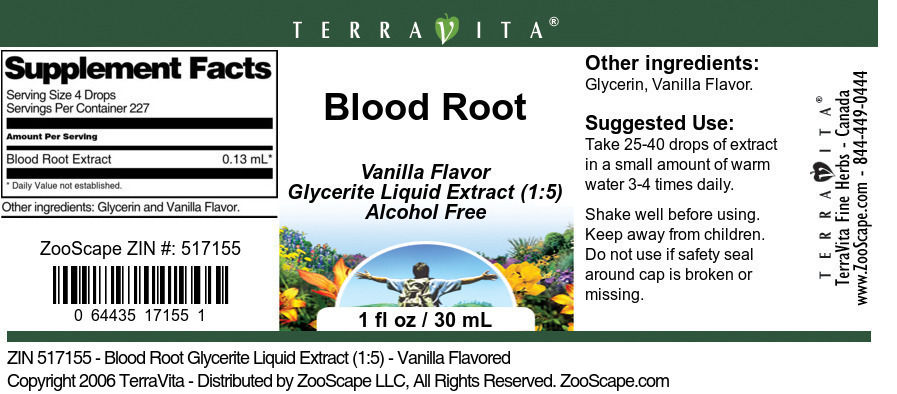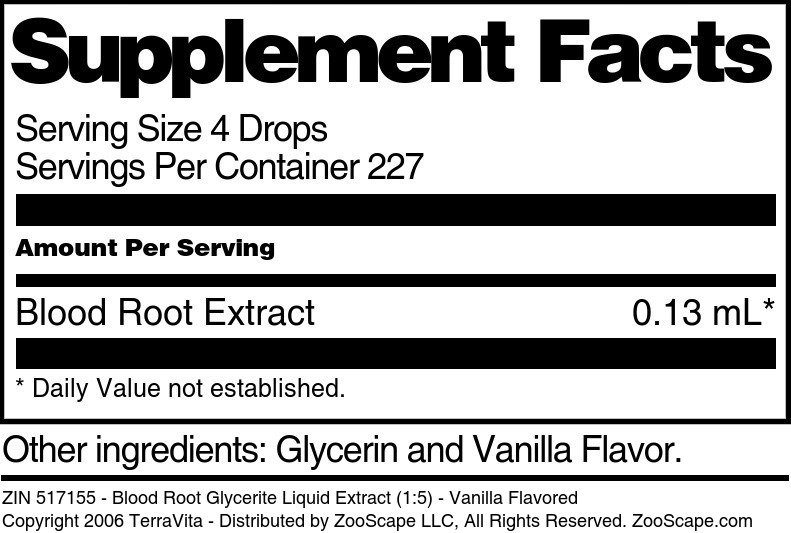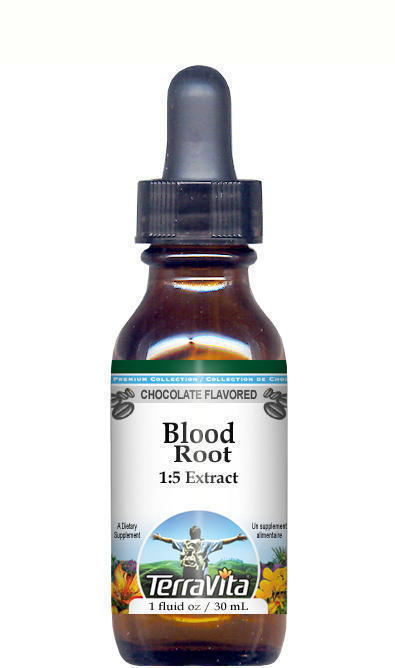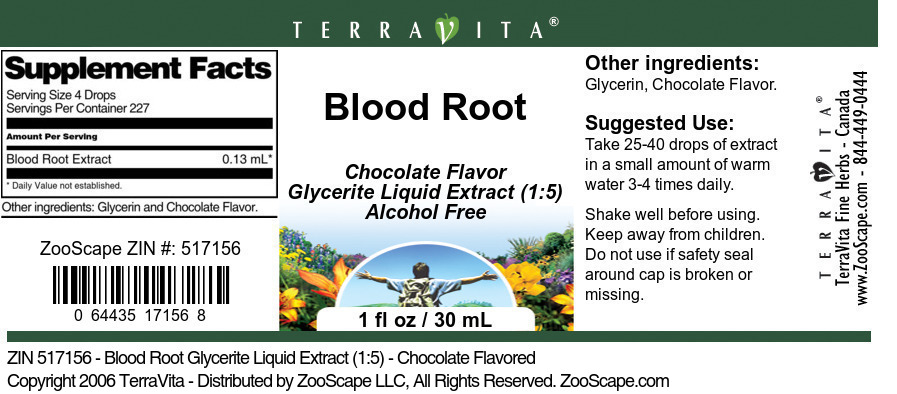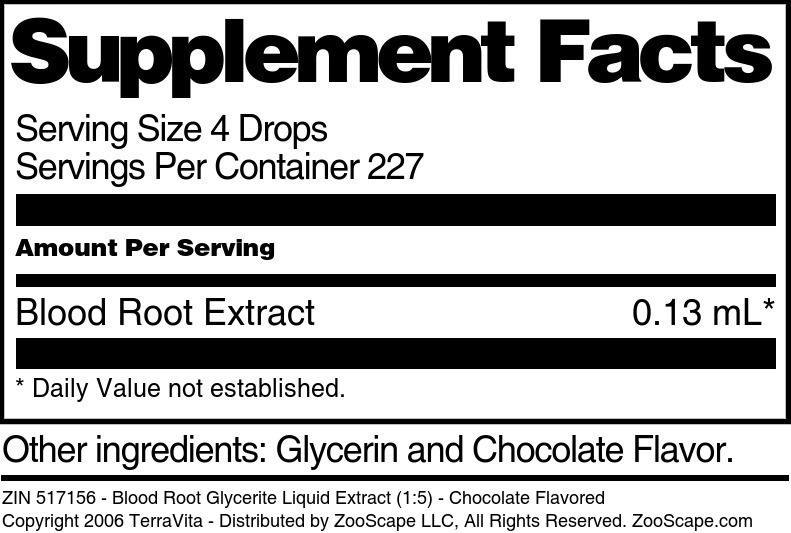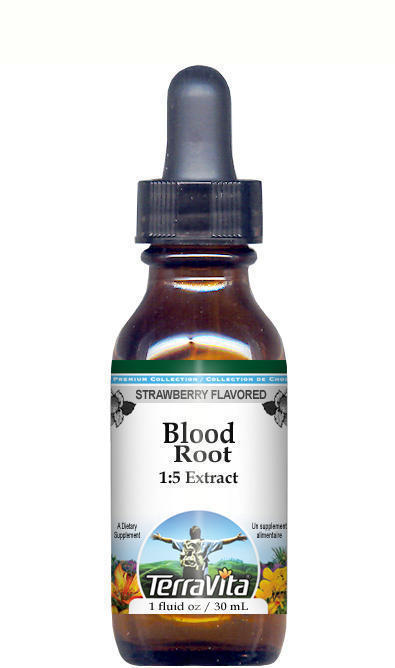Blood Root
| Images | Product Name | Size | ZIN | Price | Quantity | Add to Cart |
| Blood Root - 450 mg | 100 capsules | 516922 | $43.70 | |||
| Blood Root Powder | 1 oz | 516924 | $17.26 | |||
| 4 oz | 516923 | $55.32 | ||||
| Blood Root Tea (Loose) | 4 oz | 516925 | $45.86 | |||
| 8 oz | 516926 | $80.11 | ||||
| Blood Root Tea | 25 tea bags | 516927 | $38.40 | |||
| 50 tea bags | 516928 | $63.85 | ||||
| Blood Root Cream | 2 oz | 517151 | $26.83 | |||
| Blood Root - Salve Ointment | 2 oz | 517152 | $31.32 | |||
| Blood Root Glycerite Liquid Extract (1:5) | 1 oz - No Flavor | 517153 | $17.53 | |||
| 1 oz - Mint | 517154 | $18.35 | ||||
| 1 oz - Vanilla | 517155 | $18.35 | ||||
| 1 oz - Chocolate | 517156 | $18.35 | ||||
| 1 oz - Strawberry | 517157 | $18.35 |
Referring to the plant by its Indian name, puccoon, Capt. John Smith in 1612 recalled his experience with bloodroot in Jamestown, Virginia, noting: "this they use for swellings, aches, annointing their joints, painting their heads and garments." But that, Smith confessed, was not all they painted. He added, "they set a woman fresh painted red" to be a bedfellow of one of the colonists. Such was the Indians' fascination with bloodroot juice.
The properties of this native plant, the settlers discovered, were more for health than decorative. As they learned from the Indians (who used the blood-red juice to help support sore throats and immunity issues and an infusion of the rhizome for joint pain), bloodroot is a powerful herb. Both the powdered rhizome and the juice from it are extremely caustic, chemically capable of corroding and destroying tissue. Therefore bloodroot came to be prescribed as supportive for immunity, growths , and nose polyps. Folk healers also recommended bloodroot as an emetic (to induce vomiting), as an expectorant for coughs, as a laxative, and even as a stimulant for the digestive organs.
Research indicates that the red juice in the rhizome is an escharotic, a caustic substance that produces a mass of dead tissue after application. Bloodroot's effectiveness in specifically supporting disinfecting and for skin irritations is probable, but has not been proved, nor has its use as an expectorant (since the plant may be toxic when taken internally).
General Herb Information
Habitat: Wet banks, fields, woods.
Range: Native to North America from Quebec south to Florida and Texas and west to Kansas. Bloodroot is an endangered or threatened species in some states.
Identification: A low-growing perennial, bloodroot has an orange-red rhizome (underground stem) from which solitary blooms emerge. Each bloom is enveloped in a single leaf that enlarges after flowering and is pale green and lobed. White flowers (March-May) usually have eight petals.
Sanguinaria canadensis L.
The genus name Sanguinaria, Latin for bloody, and the common names, reflect the orange-red latex which oozes as a juice from damaged areas of all parts of the plant, but especially from the rhizome.
English Common Names
Bloodroot, puccoon (from the name in Algonkian languages, poughkone), Indian paint, Indian plant, Indian red paint, cooriroot, paucon, pauson, red paint root, red puccoon, red root, sanguinaria, snakebite, sweet slumber, tetterwort (tetter is an Old English word for various skin problems , and skin irritations).
French Common Names
Sanguinaire, sanguinaire du Canada.
Morphology
Sanguinaria canadensis in the poppy family (Papaveraceae) is the only species of its genus. It is a low-growing (Ca. 15 cm high when flowering; to 50 cm at maturity) perennial herb, produced from a branching, horizontal, reddish-brown, succulent rhizome, from which stems arise aerially at various points, while beneath the ground there are many adventitious roots. Each stem generally produces a solitary basal leaf (sometimes two), which in its early development envelops and protects a single long-stalked flower 2.5-5 cm broad (or even larger in cultivated plants), with 4-16 fugaceous white or rarely pink petals (more in a cultigen, as noted below). Flowering occurs in very early spring. As flowering progresses, the leaf continues to grow, developing a striking orbicular or reniform blade 6-30 cm broad, with 6-9 palmately arranged lobes, the lobes themselves sometimes lobed. The petioles arise beneath the ground, and may elongate to as much as 30 cm, so that the mature leaf overtops the fruit. The solitary, narrow capsule is 3-6 cm long, and splits when mature into two persistent valves, releasing the numerous 3 mm long seeds, each with a large crest.
Classification and Geography
Bloodroot is indigenous to eastern and central Canada and the US, occurring from Nova Scotia west to Manitoba and Nebraska, and south to Alabama, Arkansas and Florida. It is more common inland than on the Coastal Plain, and sometimes Blood root has become infrequent in areas where it has been gathered for health. Plants of the southern US range are sometimes segregated as var. rotundifolia (Greene) Fedde.
Ecology
Bloodroot grows best in shaded, cool, moist open hardwood groves and on well-drained woodland slopes, on circumbasic soils. In favorable situations large colonies may be formed, although sometimes only scattered individuals are encountered.
The attractive flowers have no nectar and the plant self-pollinates readily. However, the blossoms can supply some pollen to foraging insects. Several species of ants are attracted by small, oily protuberances on the surface of bloodroot seeds. The ants carry the seeds to their underground nests. It has been suggested that this increases seed survival and seedling establishment, reducing losses from foraging insects, birds and rodents. Dispersal of seeds by ants, i.e., myrmechory, is a widespread mutually beneficial relationship. The ants benefit by consuming the elaiosomes (nutritive tissues of the propagule developed specifically for the ants), while the plants benefit by having their seeds planted, often in areas rich in soil nutrients. Seneca snakeroot, discussed in this work, is also ant-dispersed.
Medicinal Uses
Traditionally, bloodroot was commonly used by North Indigenous Peoples before the arrival of European settlers, for such ailments as joint pain, asthma, coughs, laryngitis, and fevers. It was frequently employed orally as an emetic and as an expectorant (especially in supporting coughs), and topically as an ointment for skin irritations and immunity issues, both by Indians and settlers, and these usages were continued in modern western medical practice of the early part of this century. Traditional health uses of bloodroot have largely been abandoned because of the toxicity of the plant, although it has been established that bloodroot has immunity-supporting properties. Despite its toxicity, bloodroot continues to be used in health, and is present in more than a dozen commercial preparations marketed in Canada, usually as expectorants, cough syrups and liquid extracts. Lexat is an Australian product for digestive disorders that contains bloodroot. Bloodroot is no longer recommended as an emetic. The most recent modern medical use of bloodroot arises from its bactericidal and bacteriosiatic properties against oral plaque-forming organisms. Sanguinarine has been the active agent in anti-plaque, anti-gingivitis oral rinses and toothpastes, the most well known of which is the brand Viadent. However, very recently sanguinarine has been removed from Viadent formulations by the manufacturer, Colgate, because of new evidence linking the development of lesions with its prolonged use (see Damni et al. 1999).
Chemistry
The physiological activity of bloodroot is due to benzophenanthridine alkaloids, found mainly in the rhizomes, and constituting 3-9% of the rhizomes. Sanguinarine makes up 50% or more of these alkaloids, and is considered the most important. The older rhizomes have more sanguinarine than the younger. Sanguinarine is water-soluble, and is responsible for the orange-red color of the latex of bloodroot. It has been shown that there is a north-south ecodine in the US in sanguinarine content, the southern populations having a higher content Several of the alkaloids present also occur in garden poppy (not surprising since garden poppy and bloodroot belong to the same family, the Papaveraceae), and have some feeble narcotic potential. Sanguinarine strongly inhibits root rot fungi, and may protect the perennial rhizome.
Non-medicinal Uses
Bloodroot is cultivated in gardens for its showy flower and striking foliage. As an ornamental, it is most useful as an early-flowering border plant in shady locations. Since it is uncommon, it should not be transplanted from the wild, but rather established from seeds or from horticultural suppliers who have propagated their stock, not merely collected wild plants. The petals of wild plants are easily lost to wind and rain, but a popular mutant form with extra petals, called "peony flower" and "double bloodroot," or known by the cultivar names "Multiplex" and "Florepleno," arose in the Mid-western US about 1950. This has extra petals in place of the stamens, but is sterile, and must be cultivated from rhizomes and not from seeds.
The reddish juice of bloodroot is a very effective dye, and was much used by Indigenous Peoples as a body paint, and to decorate baskets, weapons, implements, and clothing (hence the name "Indian paint"). Early colonists also used the plant to dye cloth, and it was exported to Europe for this purpose. Some Indian groups also employed bloodroot in religious services, and as an insect repellent.
Agricultural and Commercial Aspects
Most bloodroot rhizomes acquired for commerce come from harvesting wild eastern US plants. ithizomes of plants that are 2 or more years old are excavated in late summer, and dried after the brittle, wiry roots are removed. In the past it was often recommended that collecting be carried out in the fall, after the foliage dies down, although more recent work suggests that the time of highest concentration of alkaloids is during or immediately after flowering. Collected rhizomes vary from 2 to 7 cm in length, and from 5 to 15 mm in diameter. The orange-red latex oozes from the broken ends, forming a reddish resinous coating upon drying.
In the last decade it has been found that sanguinarine can be obtained from alternative sources, so that cultivating bloodroot for this chemical is doubtfully worthwhile. Sanguinarine occurs in the Asian Macleaya cordata (Willd.) R. Br. (Bocconia cordata), the plume poppy, and since this species is relatively easily cultivated it is a potential competitive commercial source of the alkaloid. Moreover, technology has advanced to the point that sanguinarine is being produced commercially from tissue culture in large vats, for use in toothpaste and mouthwash. Nevertheless, bloodroot extracts are the subject of considerable ongoing scientific research. Although cultivation is of limited agricultural interest in Canada today, the remarkable chemistry of bloodroot is believed to have economic potential.
Myths, Legends, Tales, Folklore, and Interesting Facts
- Bachelors of the Ponca tribe used bloodroot as a love charm. Applying the red juice to the palm and shaking hands with the woman they wanted to marry was believed to induce consent.
Applied for lungs, inflammation of the air passages, asthma, chronic respiratory issues, croupe, inflammation of the larynx and more.
Used for lungs, coughs, asthma attack, emphysema, croupe, laryngitis and more.
Applicable for lungs, coughs, asthma attack, chronic respiratory issues, laryngitis, laryngitis plus more.
Common names for blood root include red root, red indian paint, and tetterwort. This bitter root affects the lungs, heart, liver, and blood, and it has been used historically to help support complaints such as coughs, sore throat, skin eruptions, skin problems, athlete's foot, and gum health. Biochemically speaking, the herb contains isoquinoline alkaloids, including sanguinarine, berberine, coptisine, and others. The healthy actions of the herb may be expectorant, stimulant, alterative, diuretic, febrifuge, sedative, or emetic in larger doses.
Bloodroot is primarily used as an expectorant for acute and chronic coughs, nasal congestion, laryngitis, sore throat, asthma with thick white phlegm, and croup. For pneumonia use doses of one to two drops taken repeatedly throughout the day. It also combines well in cough syrups with eucalyptus, wild cherry bark, elecampane and honey.
Externally it is applied as a liquid extract, powder, or most often as an ointment for the potential to help support symptoms of a wide variety of skin affections, including athlete's foot and other fungoid complaints, skin problems and burns. Most recently it has been used as pan of a dentifrice in a small amount with cinnamon bark, bayberry bark, prickly ash, and other agents to help support gum health and sensitive teeth. Bloodroot is used in a salve often called black paste for skin problems, moles, and other topical excrescences.
Used for lungs, coughs, asthma, emphysema, croup, laryngitis and more.
Blood Root
Sanguinaria canadensis L.
Papaveniceae, Poppy family.
Other Common Names: Red Puccoon, Indian Paint, Tetterwort.
Blood Root is native to North America, east of the Great Plains from Canada, south to Florida. It is found in rich and usually open woodlands.
Blood Root is one of the very first plants to flower in the spring. As it first rises out of the ground, the single, small, reniform (kidney-shaped), lobed leaf is wrapped around the bud. Once out of the ground, the bud swiftly outgrows its protecting leaf. The flower bursts free of two enclosing sepals which fall away to expose eight to twelve spreading white petals. In the center of the petals is a cluster of golden stamens, usually twice as many stamens as the number of petals. The flower is followed in late spring by a slender, two-valved seed capsule containing numerous seeds. During the rest of the growing season, the leaf comes into its own and can attain a size of twelve inches across.
When fresh, the root is about the size and shape of a man's finger; when cut or broken, it bleeds a red juice. Indians used the root medicinally, and to paint their bodies for various occasions.
Calling the plant by its Indian name, Puccoon, John Smith wrote in 1612, "Pocones is a small root that groweth in the mountains which being dryed and beate in powder turneth red and this they use for swellings, aches, annointing their joints, painting their heads and garments." But that's not all they painted. "...and at night where his lodging is appointed, they set a woman fresh painted red with Pocones and oile, to be his bedfellow."
Colonel William Byrd, Virginia planter and scholar, in his History of the Dividing Line, (North Carolina - Virginia) wrote that such practices were still going on in 1729, much to the chagrin of the chaplain of his survey party, who "observ'd with concern that the Ruffles of Some of our Pellow Travellers were a little discolor'd with pochoon, wherewith the good Man had been told those Ladies us'd to improve their invisible charms." My research indicates that this is the first recorded case in the New World of what in modern times is known as "lipstick on the collar, telling a tale on you!"
Blood Root is still used today as a natural vegetable dye largely for wool and other textiles, now that body painting, after a brief resurgence in the 1960's, has decreased in popularity. Some excellent white oak splint basketry is still woven by the Cherokees. The splints are often dyed with Blood Root to give them a soft red color.
Health-wise,the dried rhizome of the Blood Root was official in the United States Pharmacopea from 1820 till 1926, and remained in the National Formulary from 1925 to 1965, classed as a stimulating expectorant, emetic, tonic and alterative. The plant, if taken internally, should be used with caution because, it is poisonous in all but small doses. The powder can be used as a snuff for nasal polyps. Injections of the strong tea can be used to help support hemorrhoids and vaginal infections. In small doses internally as a decoction, it acts as a stimulant to the digestive organs, as an expectorant in respiratory problems and in liquid extract form to help support liver ailments. In larger doses it may act as an emetic.
Used for lungs, inflammation of the air passages, allergies, emphysema, difficult breathing, hoarseness of the voice etc.
Sanguinaria canadensis L.
Family: Papaveraceae.
Other Names: Sanguinaire du Canada (French); Kanadische Blutwurzel (German); sanguinaria (Italian).
Description: Bloodroot is a small perennial herb (up to 0.4 m), producing a red sap or latex. It has solitary leaves and flowers emerging from a creeping, fleshy, red rhizome. The leaf has a rounded, markedly lobed blade. The attractive flower has four to 16 white petals and develops into a narrow, two-valved capsule containing numerous small seeds.
Origin: North America; mainly wild-harvested in the eastern parts of the USA.
Parts Used: Dried rhizome, with the roots removed (Sanguinariae canadensis rhizomza).
Therapeutic Category: Anti-inflammatory, dental hygiene.
Uses and Properties: Traditionally used as an emetic, expectorant and spasmolytic to help support coughs and asthma, and other ailments of the respiratory tract (cough, croup, laryngitis and pharyngitis). In former times, it was applied topically against skin irritations, warts and immunity issues. Despite its toxicity, bloodroot is still included in several commercial expectorants, cough syrups and stomachics. The most common modern use is as an ingredient of mouth rinses and toothpaste to counteract dental plaque and gingivitis.
Preparation and Dosage: Up to 0.5 g of dried rhizome is taken as an infusion (or equivalent extracts or extracts) three times per day. The emetic dose is 1 - 2 g.
Active Ingredients: Isoquinoline alkaloids (up to 9%), with sanguinarine (a benzophenanthridine) as the main compound (about 50%) and several others including chelerythrine, sanguilutine, allocryptopine, protopine, berberine, coptisine.
Health Effects: The activity is ascribed mainly to sanguinarine. It intercalates DNA binds to proteins (including various receptors) and shows anti-inflammatory, anti-germ activity. It effectively inhibits dental plaque (as demonstrated in controlled clinical studies). The expectorant and emetic effect is probably due to the alkaloids (irritation of the nervus vagus).
Notes: Sanguinarine may also be obtained from the Asian plume poppy, Mackaya cordata.
Status: Traditional health; Pharm.; clinical studies+.
Utilized for lungs, coughs, asthma, decreased respiratory function, croupe, inflammation of the mucous membrane of the larynx plus more.
Administered for lungs, coughs, asthma, chronic respiratory issues, laryngitis, hoarseness etc.
Made use of for lungs, coughs, asthma, chronic respiratory issues, laryngitis, inflammation of the larynx plus more.
Applies to lungs, inflammation of the air passages, asthma attack, decreased respiratory function, barking cough, laryngitis and so on.
TerraVita is an exclusive line of premium-quality, natural source products that use only the finest, purest and most potent ingredients found around the world. TerraVita is hallmarked by the highest possible standards of purity, potency, stability and freshness. All of our products are prepared with the highest elements of quality control, from raw materials through the entire manufacturing process, up to and including the moment that the bottles or bags are sealed for freshness and shipped out to you. Our highest possible standards are certified by independent laboratories and backed by our personal guarantee.
TerraVita exists to meet and ensure your family's health and wellness without the harmful effects or chemicals and prescription medications. We strive to make all of our products affordable and reliable and are constantly searching the market to maintain our affordability and to look for new ways to serve you and the ones you love. TerraVita has become a trusted household name for many families and can bring you and yours the very best herbal supplements, blends, teas and spices that are on the market today.
TerraVita is packed in tamper-proof, food-grade, recyclable containers.
ZooScape is proud to be the exclusive distributor of TerraVita teas, herbs and supplements in the United States, Canada and around the world. Please direct all wholesale and bulk inquiries to 1-844-449-0444.
Bianca Rosa is an exclusive line of premium-quality natural products sourced from only the finest and purest ingredients from around the world. Bianca Rosa is hallmarked by the highest possible standards of purity, stability and freshness. All Bianca Rosa products are prepared with the highest level of quality control, from the raw materials used through the entire manufacturing process, up to and including the moment that the finished product is sealed for freshness and shipped to you. Our highest possible standards backed by our personal guarantee.
Bianca Rosa makes all products as affordable as possible and we are constantly searching the market to maintain our affordability and to look for new ways to serve you. Bianca Rosa has been a trusted household name for many families throughout the world since the 1990s. Bianca Rosa is packed in tamper-proof, recyclable containers.
ZooScape is proud to be the exclusive distributor of all Bianca Rosa products, including creams, salves and oils in the United States, Canada and around the world. Please direct all wholesale and bulk inquiries to 1-844-449-0444.
TerraVita is an exclusive line of premium-quality, natural source products that use only the finest, purest and most potent ingredients found around the world. TerraVita is hallmarked by the highest possible standards of purity, potency, stability and freshness. All of our products are prepared with the highest elements of quality control, from raw materials through the entire manufacturing process, up to and including the moment that the bottles or bags are sealed for freshness and shipped out to you. Our highest possible standards are certified by independent laboratories and backed by our personal guarantee.
TerraVita exists to meet and ensure your family's health and wellness without the harmful effects or chemicals and prescription medications. We strive to make all of our products affordable and reliable and are constantly searching the market to maintain our affordability and to look for new ways to serve you and the ones you love. TerraVita has become a trusted household name for many families and can bring you and yours the very best herbal supplements, blends, teas and spices that are on the market today.
ZooScape is proud to be the exclusive distributor of TerraVita teas, herbs and supplements in the United States, Canada and around the world. Please direct all wholesale and bulk inquiries to 1-844-449-0444.
TerraVita exists to meet and ensure your family's health and wellness without the harmful effects or chemicals and prescription medications. We strive to make all of our products affordable and reliable and are constantly searching the market to maintain our affordability and to look for new ways to serve you and the ones you love. TerraVita has become a trusted household name for many families and can bring you and yours the very best herbal supplements, blends, teas and spices that are on the market today.
TerraVita is packed in tamper-proof, food-grade, recyclable containers.
ZooScape is proud to be the exclusive distributor of TerraVita teas, herbs and supplements in the United States, Canada and around the world. Please direct all wholesale and bulk inquiries to 1-844-449-0444.
Bianca Rosa is an exclusive line of premium-quality natural products sourced from only the finest and purest ingredients from around the world. Bianca Rosa is hallmarked by the highest possible standards of purity, stability and freshness. All Bianca Rosa products are prepared with the highest level of quality control, from the raw materials used through the entire manufacturing process, up to and including the moment that the finished product is sealed for freshness and shipped to you. Our highest possible standards backed by our personal guarantee.
Bianca Rosa makes all products as affordable as possible and we are constantly searching the market to maintain our affordability and to look for new ways to serve you. Bianca Rosa has been a trusted household name for many families throughout the world since the 1990s. Bianca Rosa is packed in tamper-proof, recyclable containers.
ZooScape is proud to be the exclusive distributor of all Bianca Rosa products, including creams, salves and oils in the United States, Canada and around the world. Please direct all wholesale and bulk inquiries to 1-844-449-0444.
TerraVita is an exclusive line of premium-quality, natural source products that use only the finest, purest and most potent ingredients found around the world. TerraVita is hallmarked by the highest possible standards of purity, potency, stability and freshness. All of our products are prepared with the highest elements of quality control, from raw materials through the entire manufacturing process, up to and including the moment that the bottles or bags are sealed for freshness and shipped out to you. Our highest possible standards are certified by independent laboratories and backed by our personal guarantee.
TerraVita exists to meet and ensure your family's health and wellness without the harmful effects or chemicals and prescription medications. We strive to make all of our products affordable and reliable and are constantly searching the market to maintain our affordability and to look for new ways to serve you and the ones you love. TerraVita has become a trusted household name for many families and can bring you and yours the very best herbal supplements, blends, teas and spices that are on the market today.
ZooScape is proud to be the exclusive distributor of TerraVita teas, herbs and supplements in the United States, Canada and around the world. Please direct all wholesale and bulk inquiries to 1-844-449-0444.
These statements have not been evaluated by the Food and Drug Administration (FDA). Products are intended to support general well being and are not intended to treat, diagnose, prevent, or cure any condition or disease.
